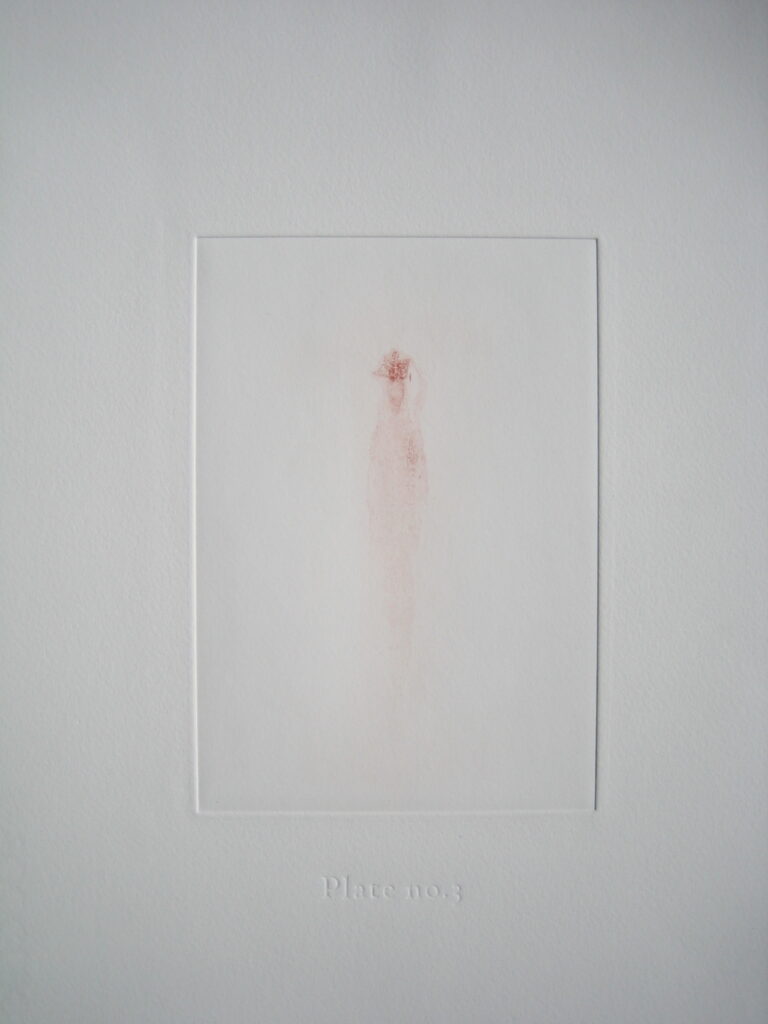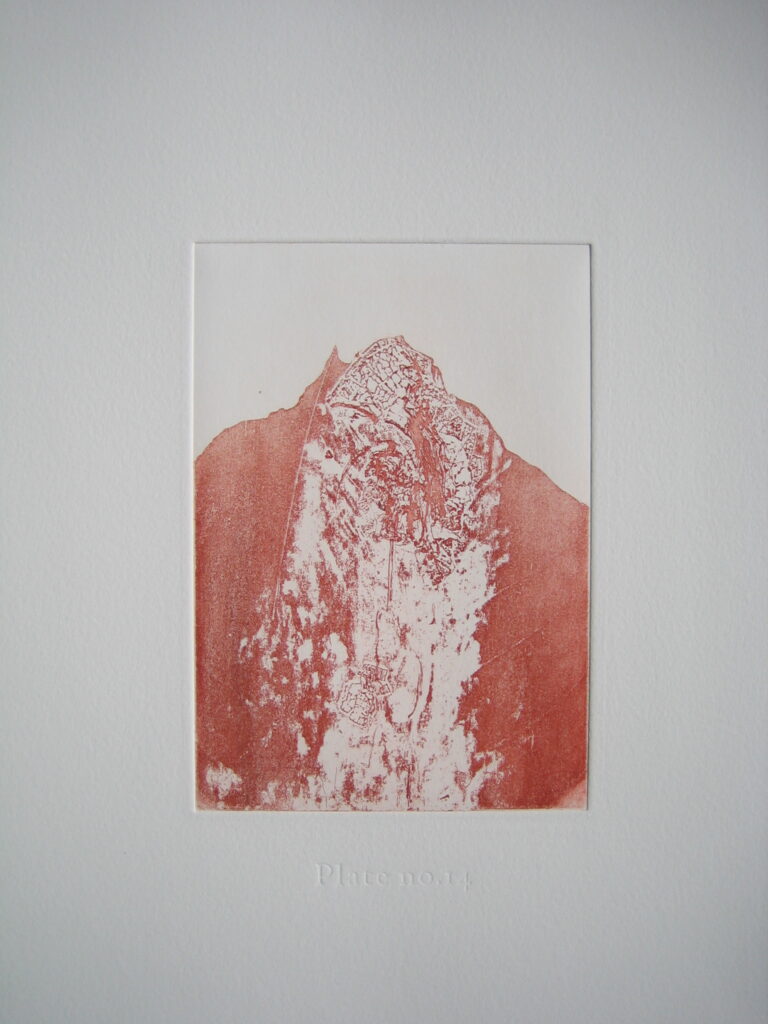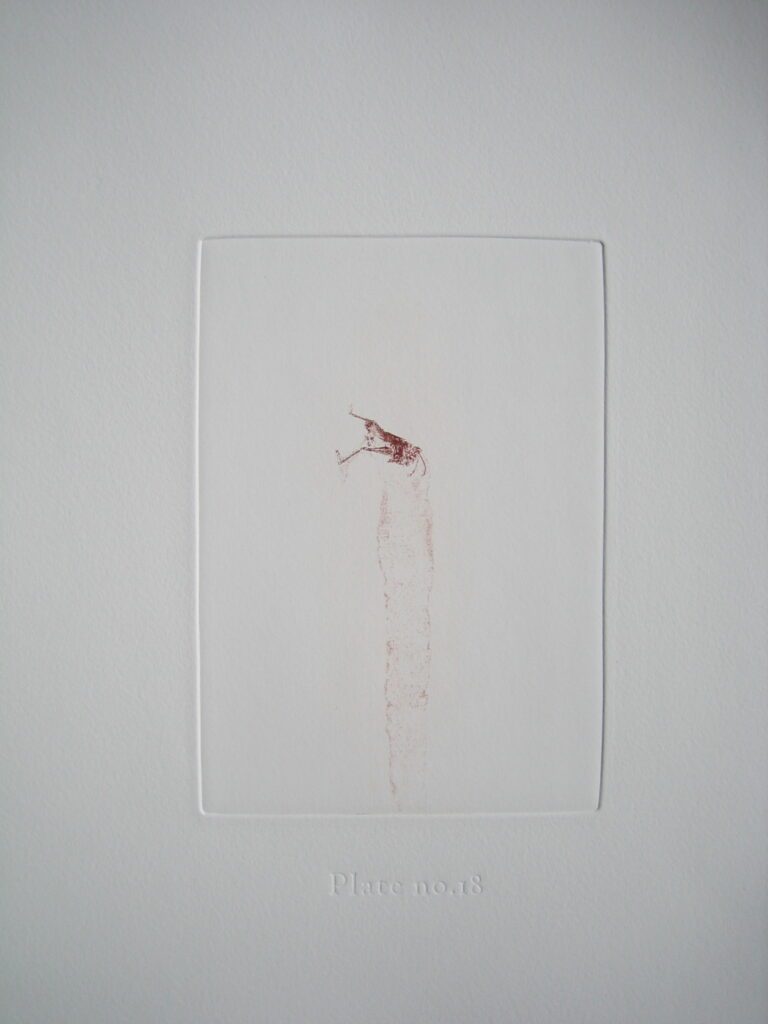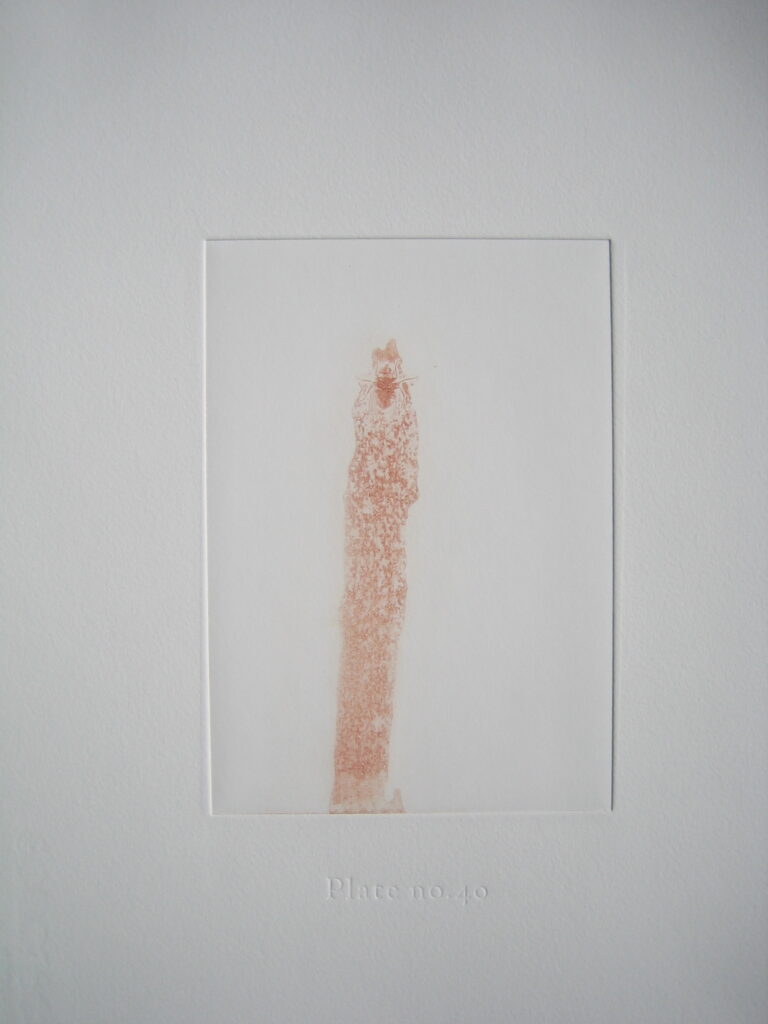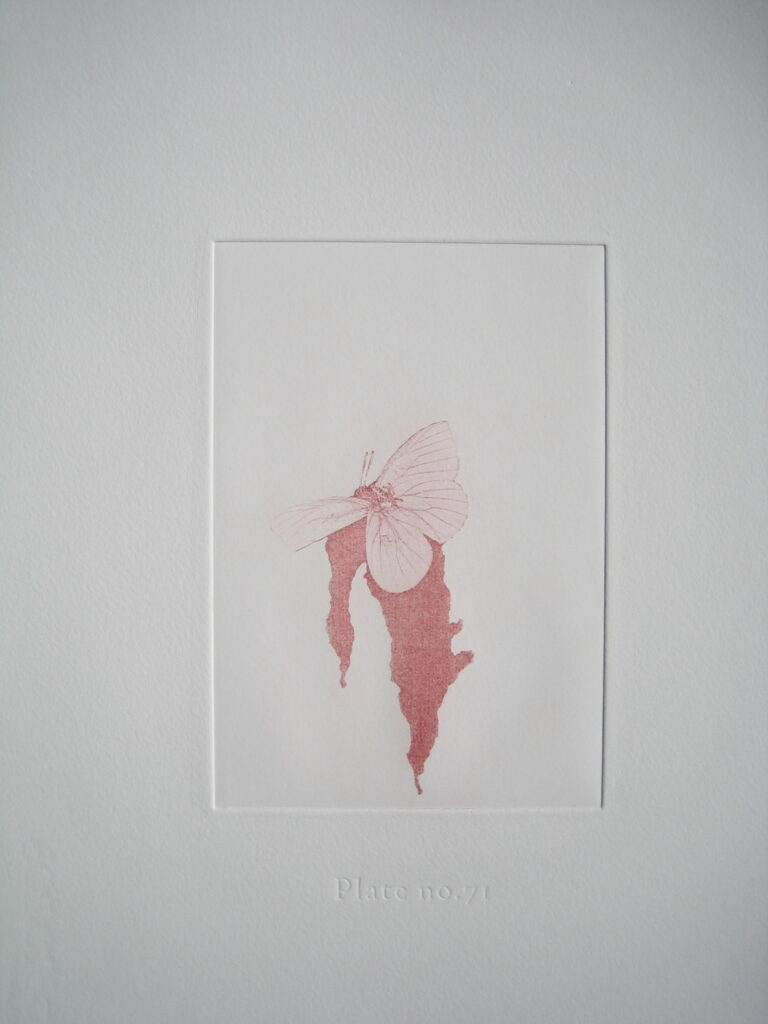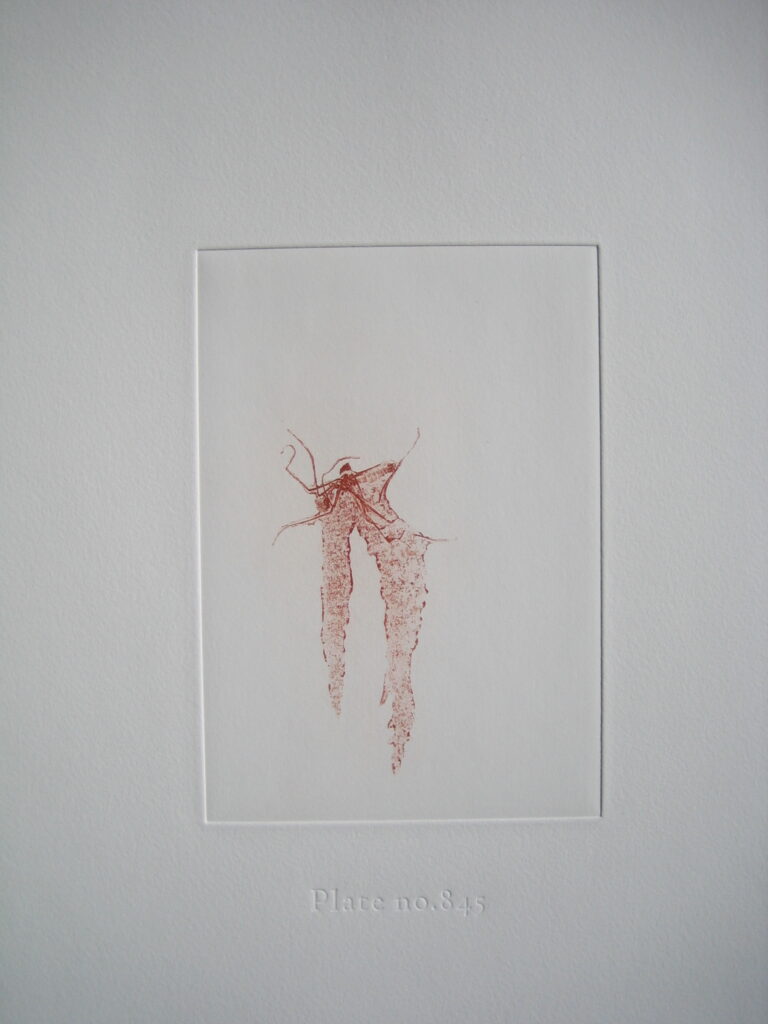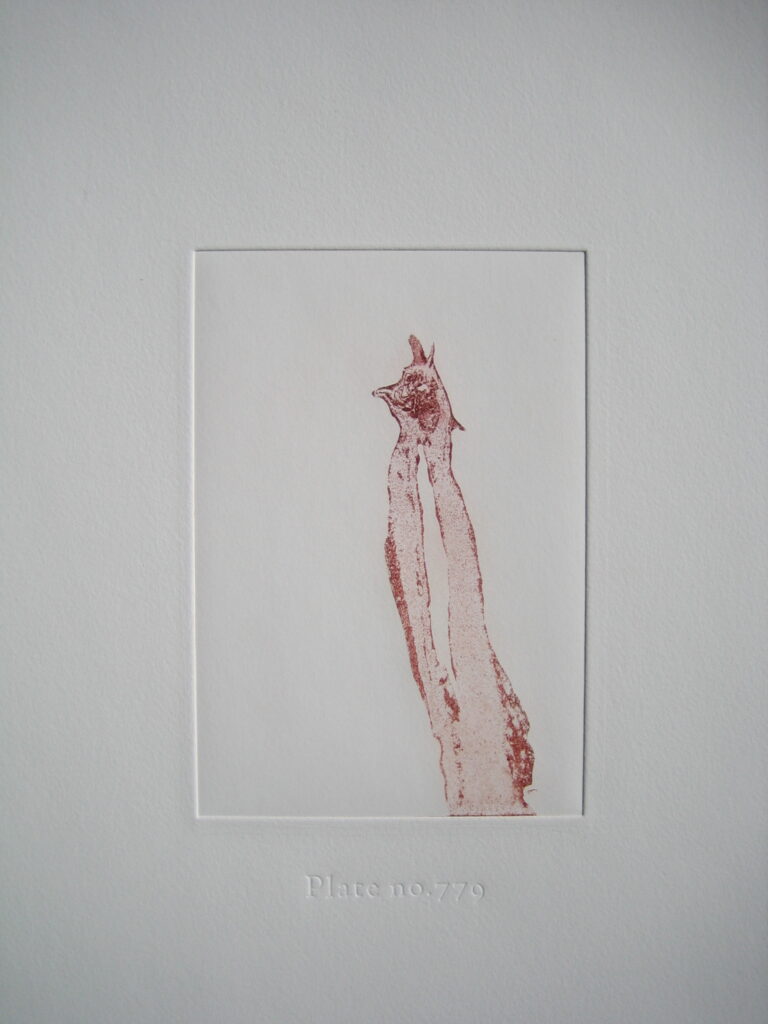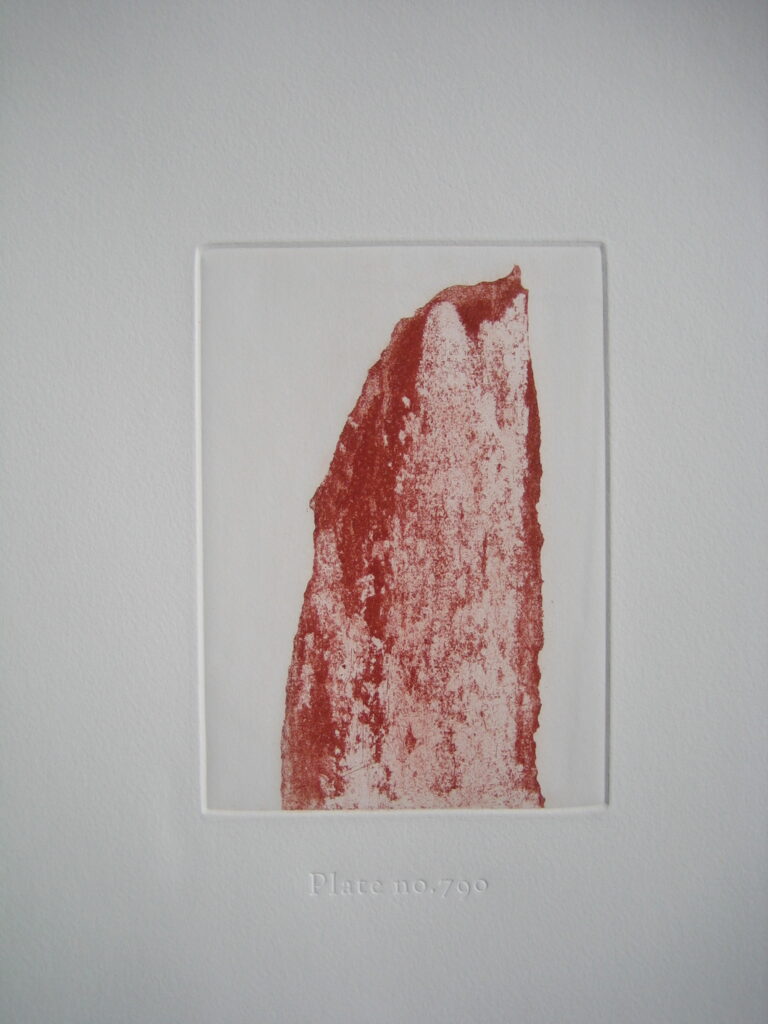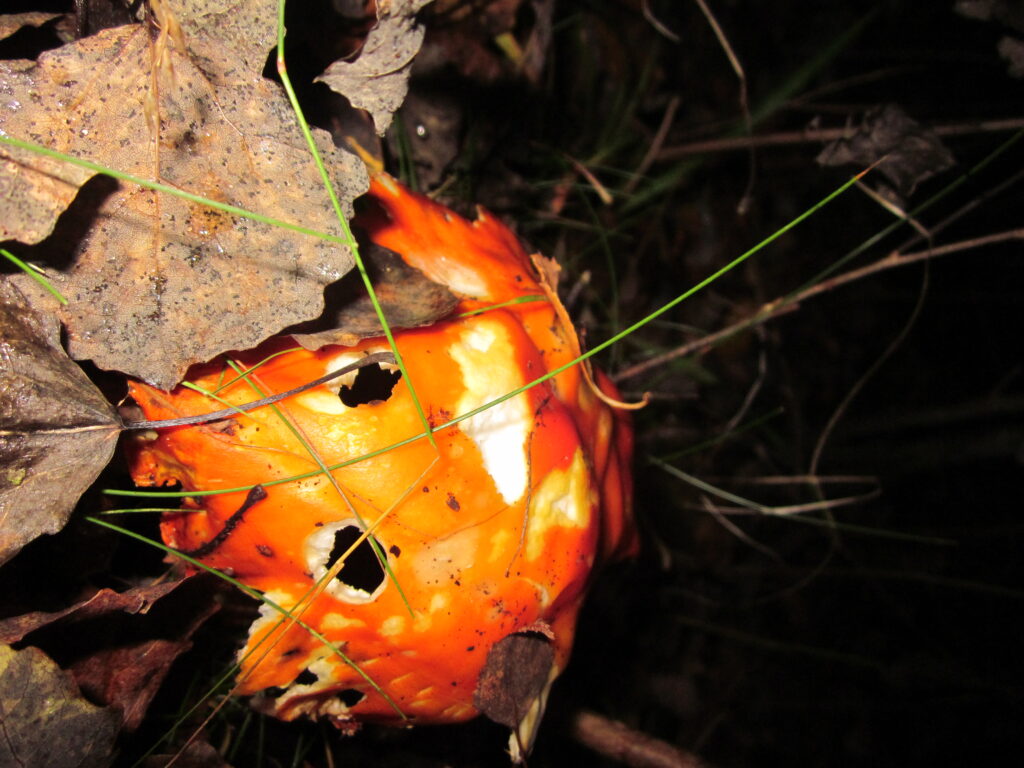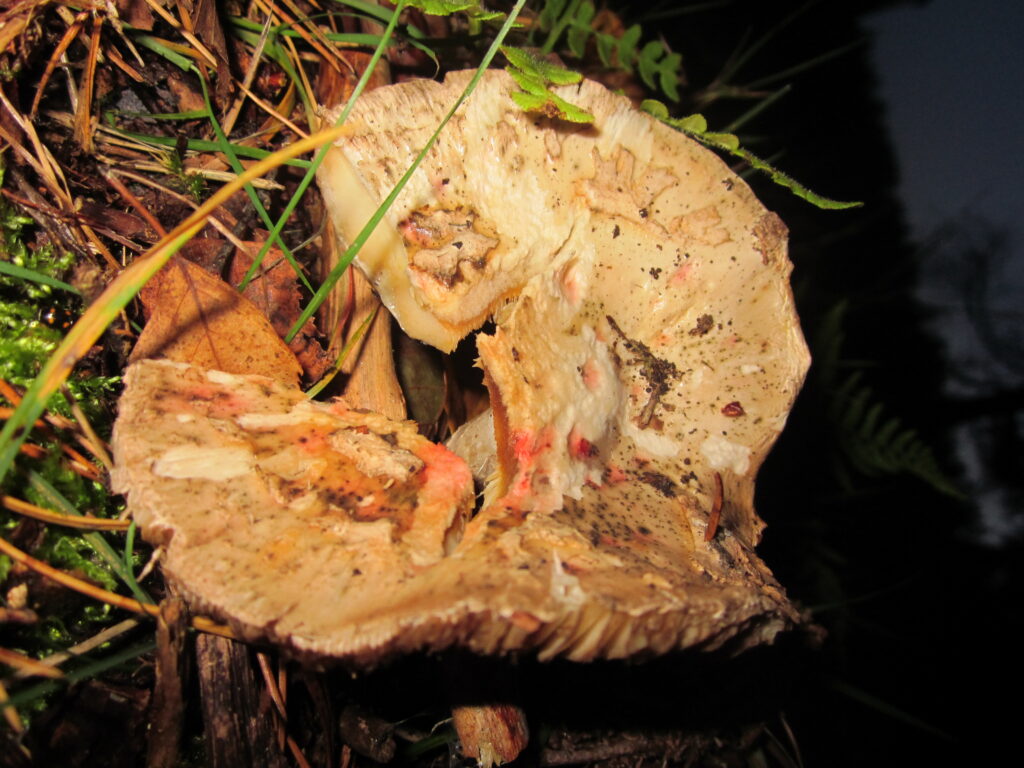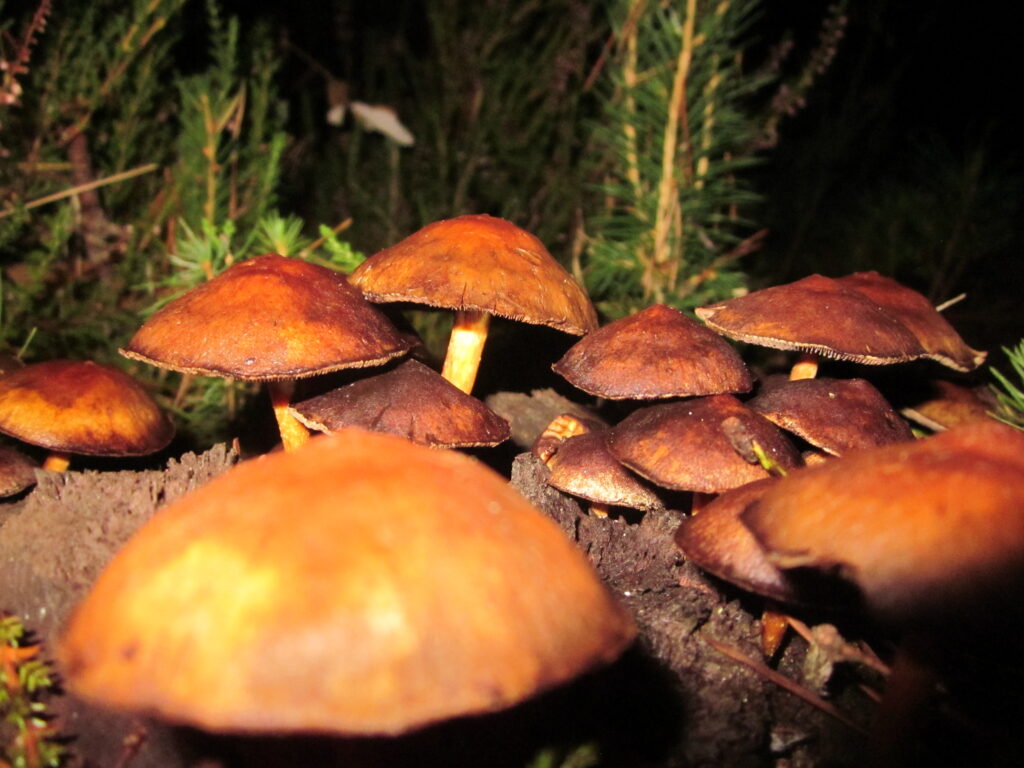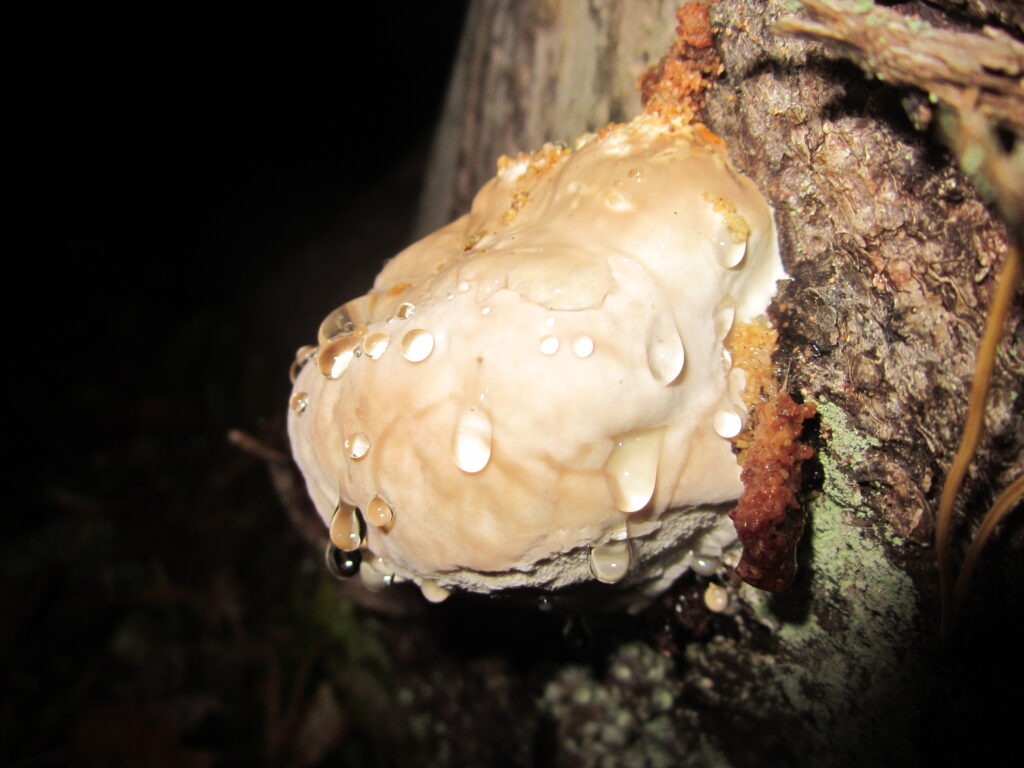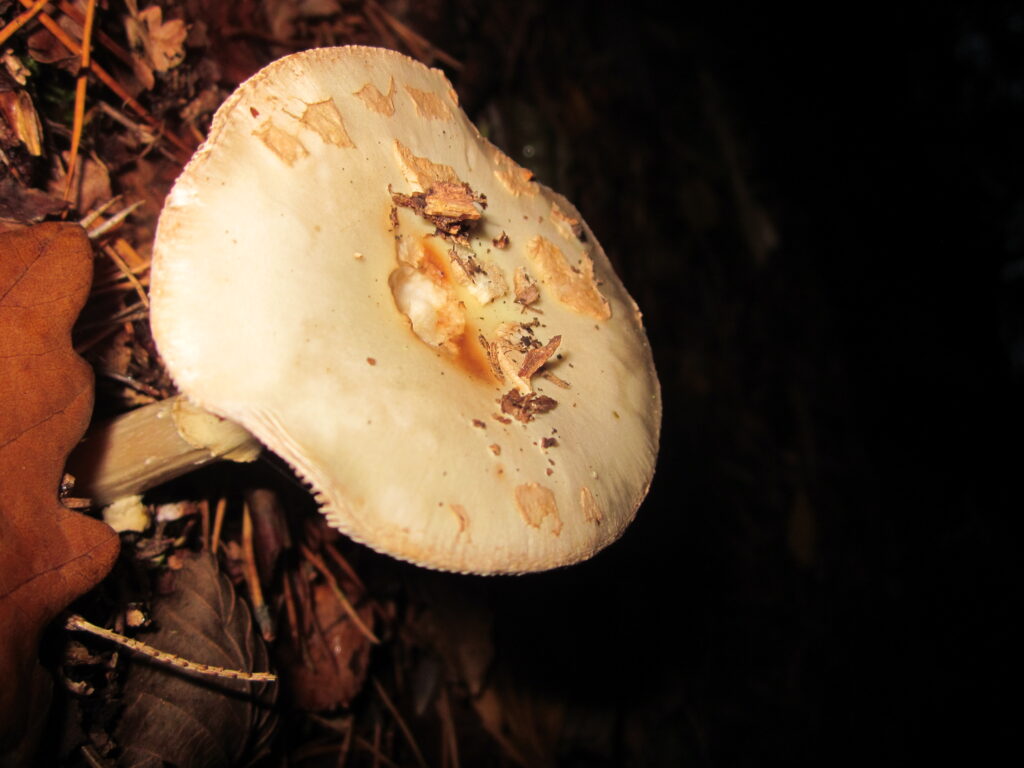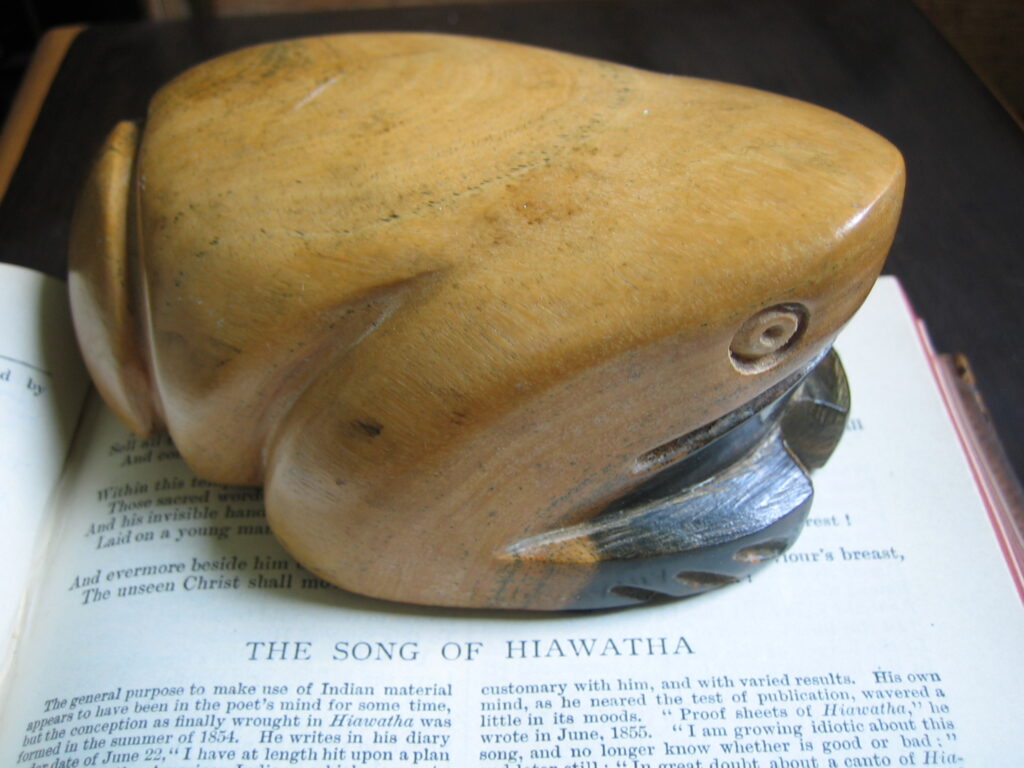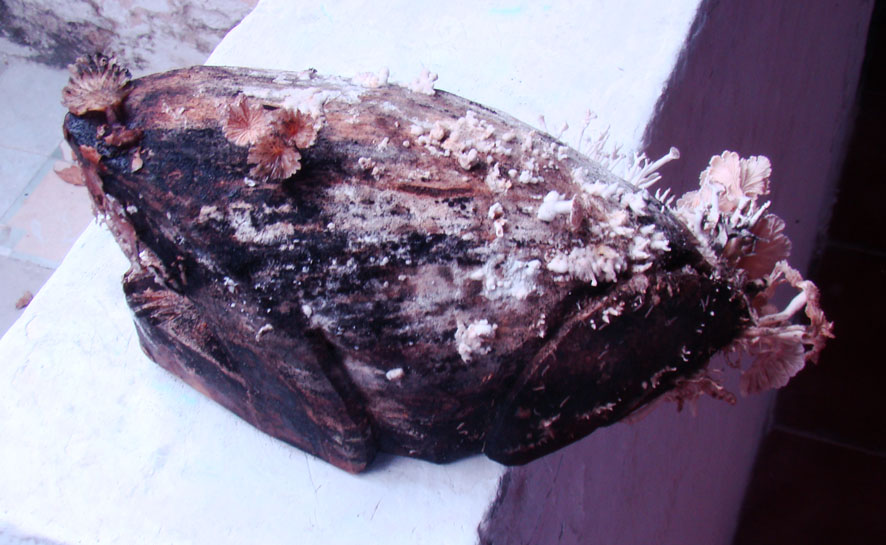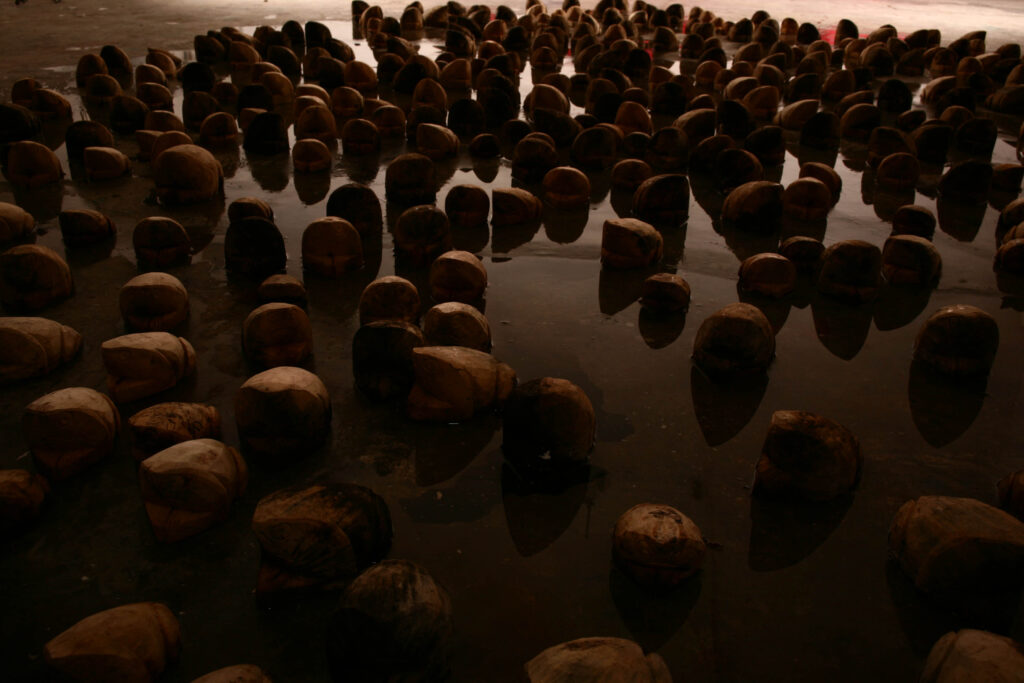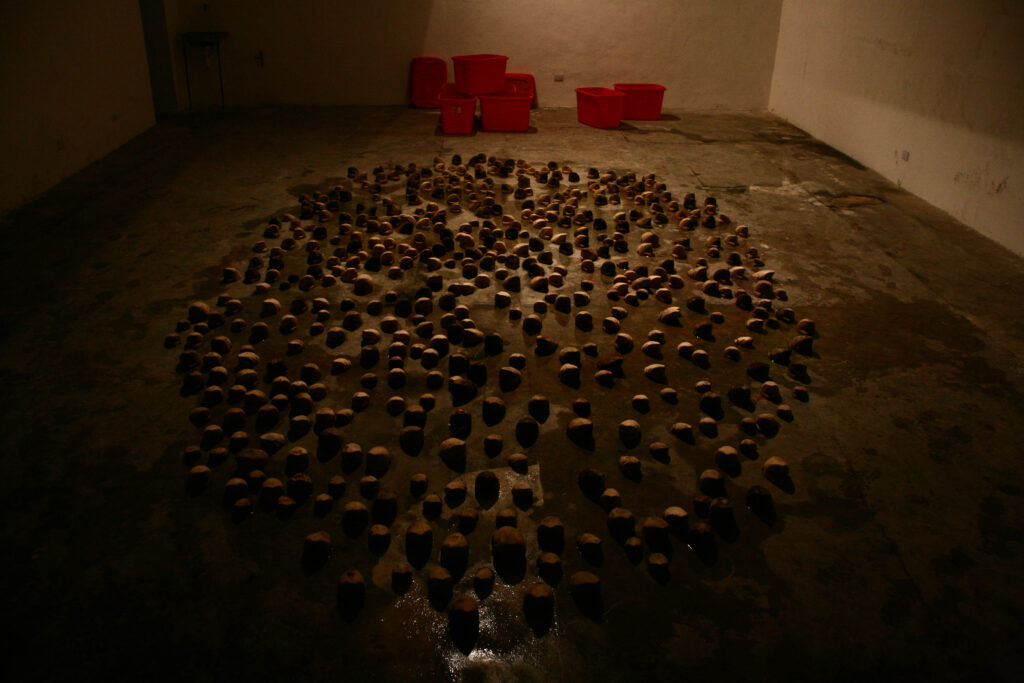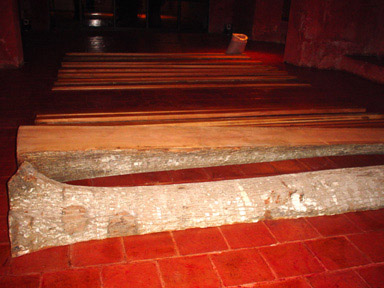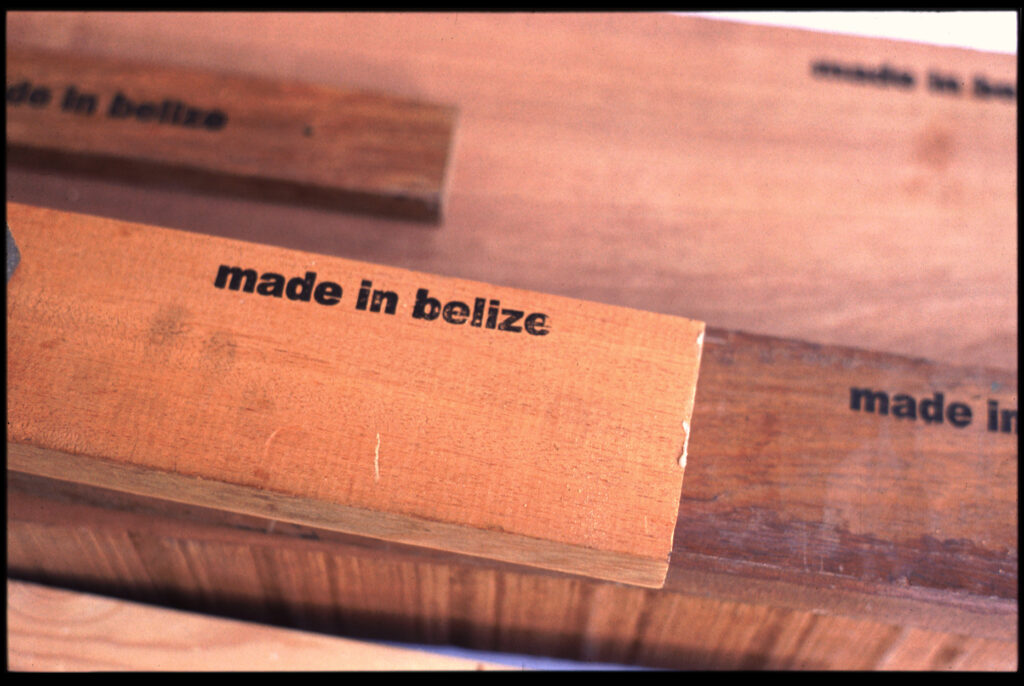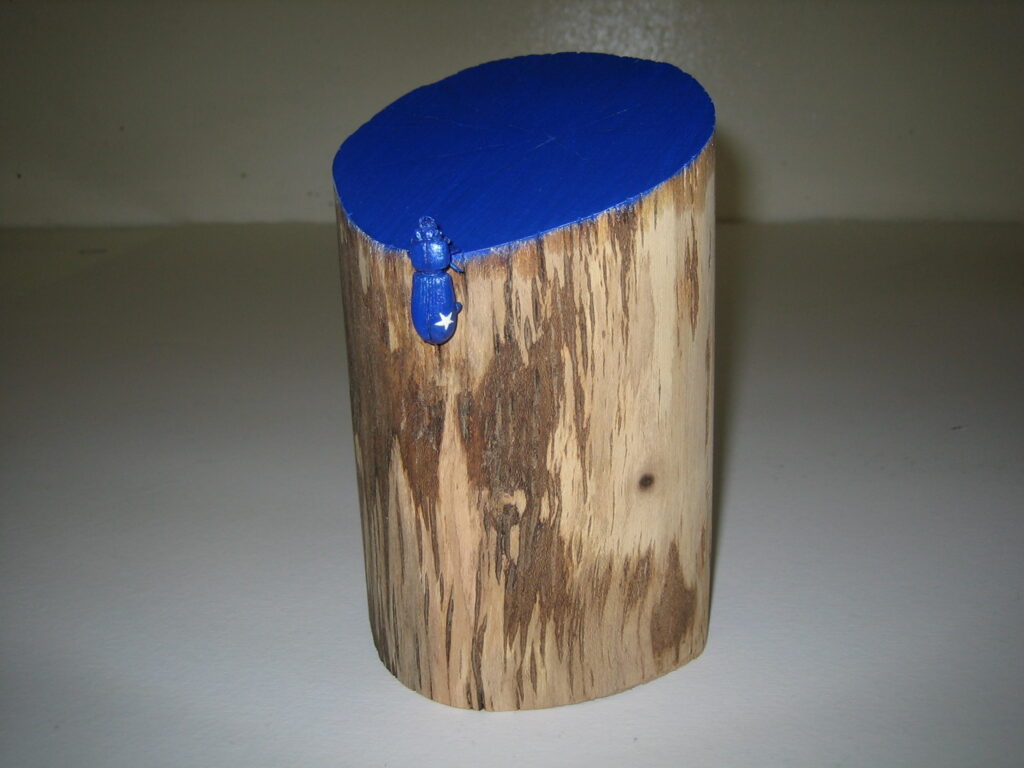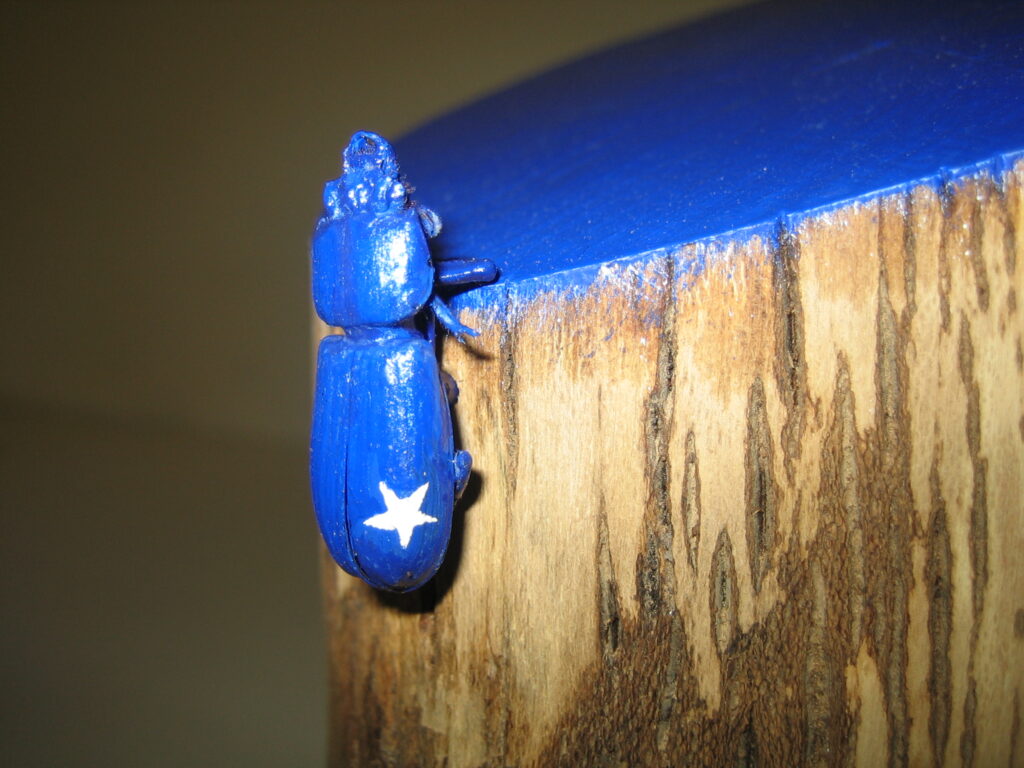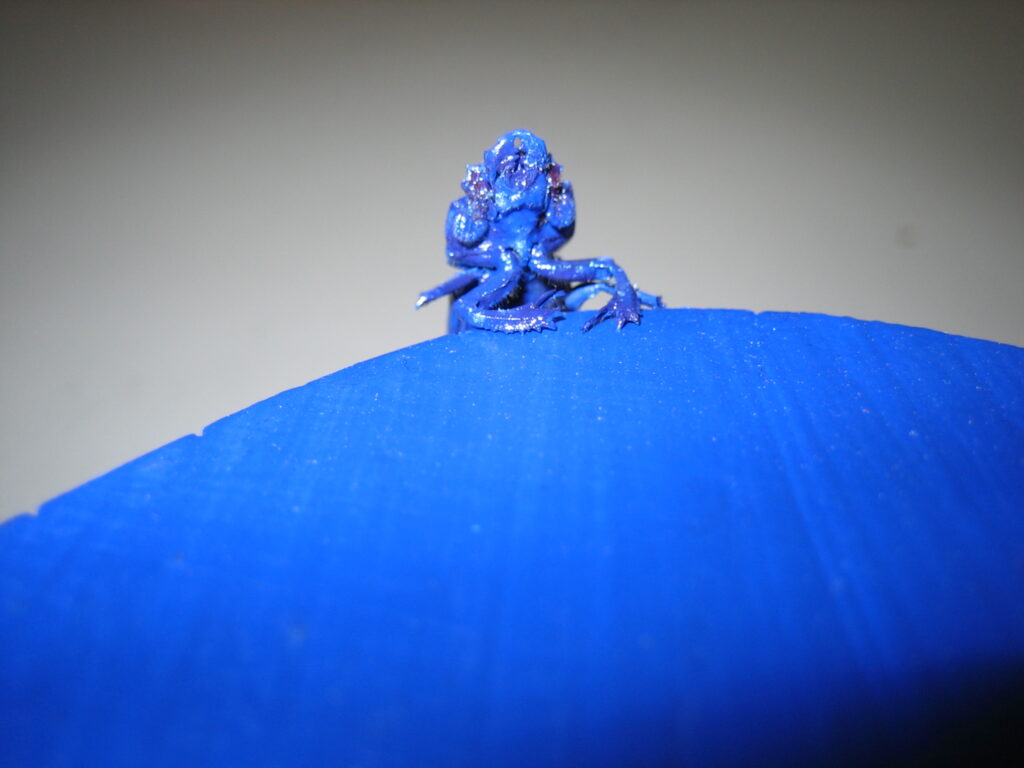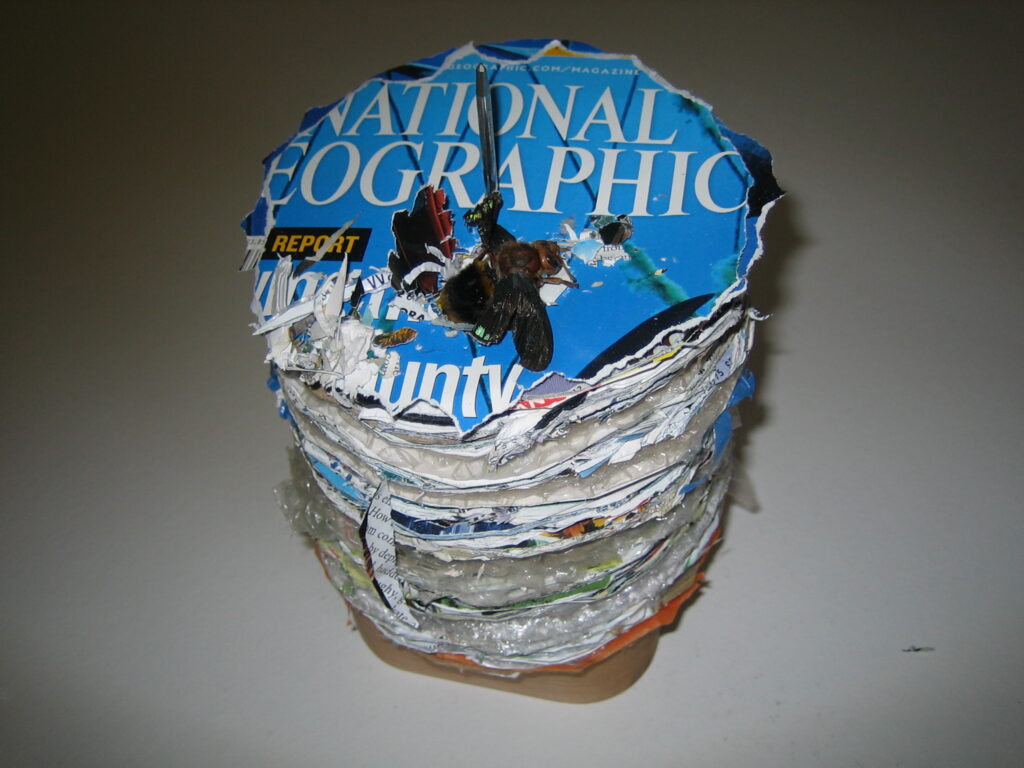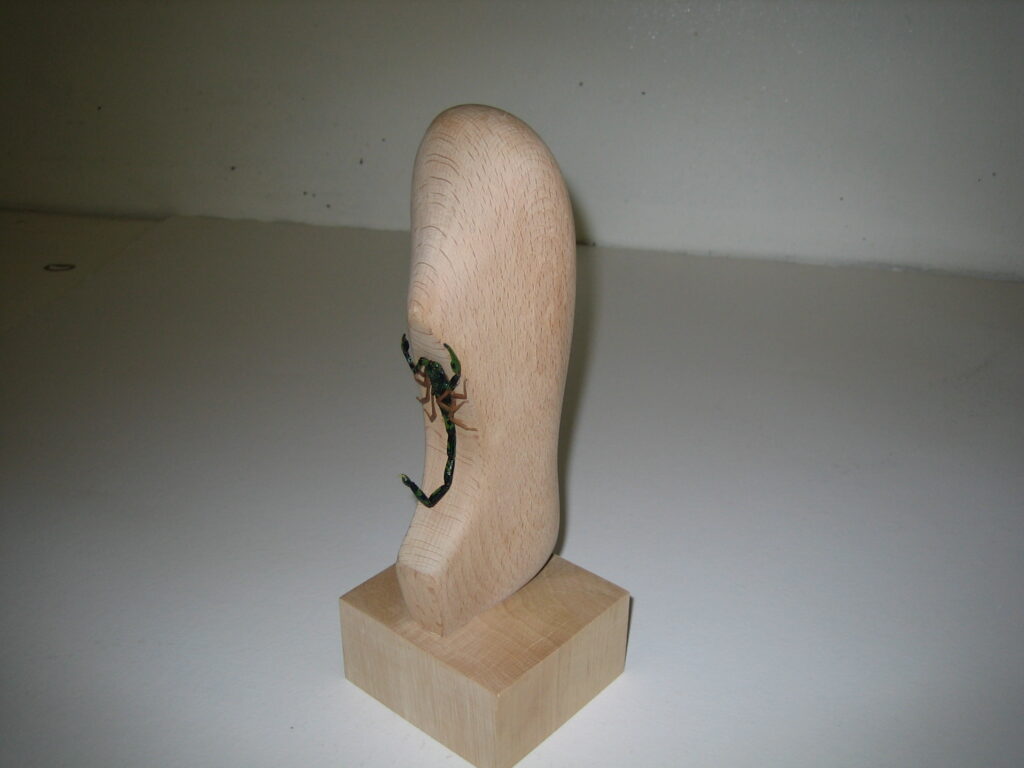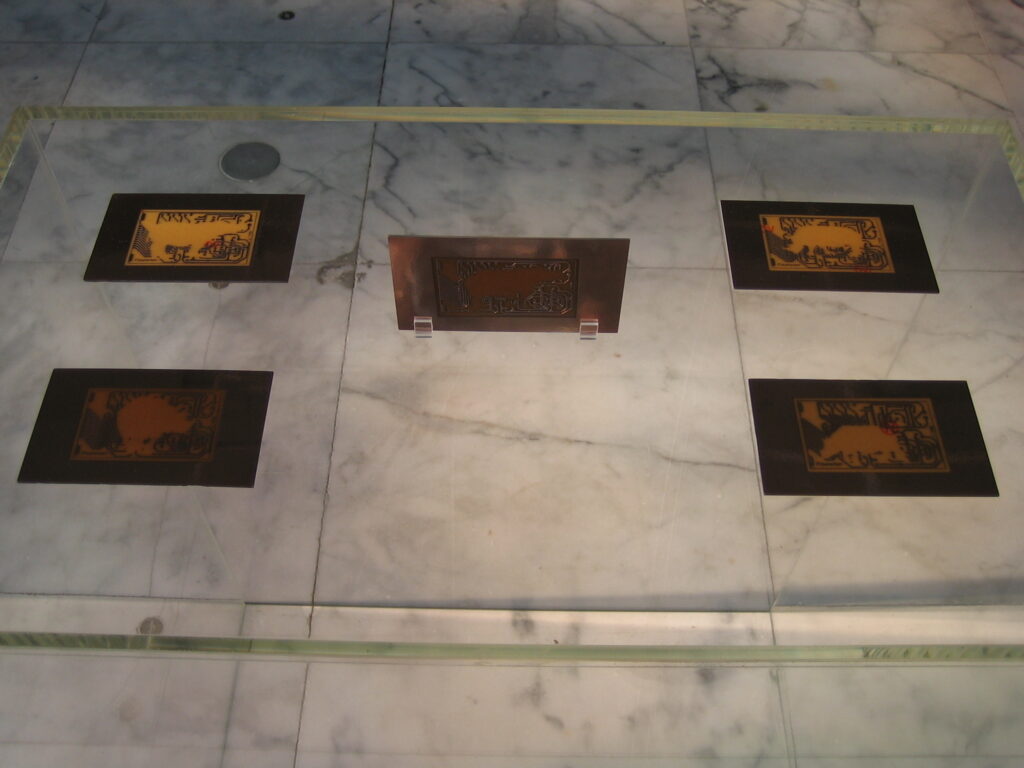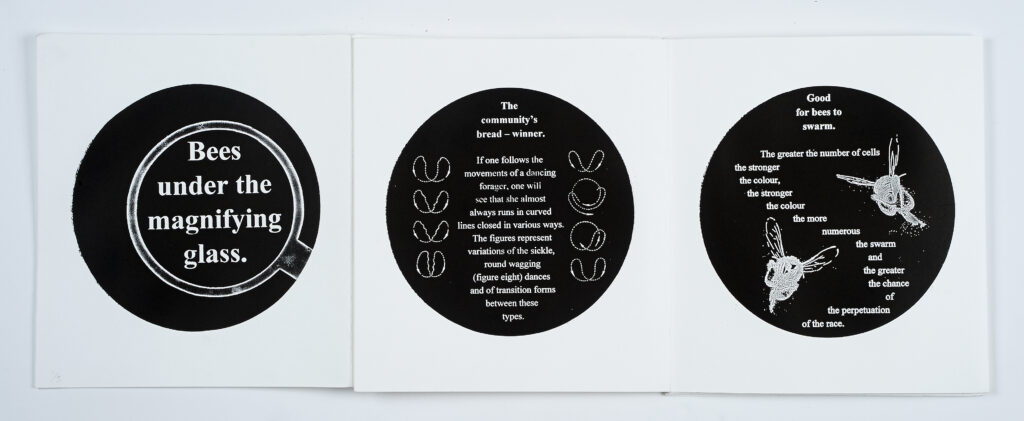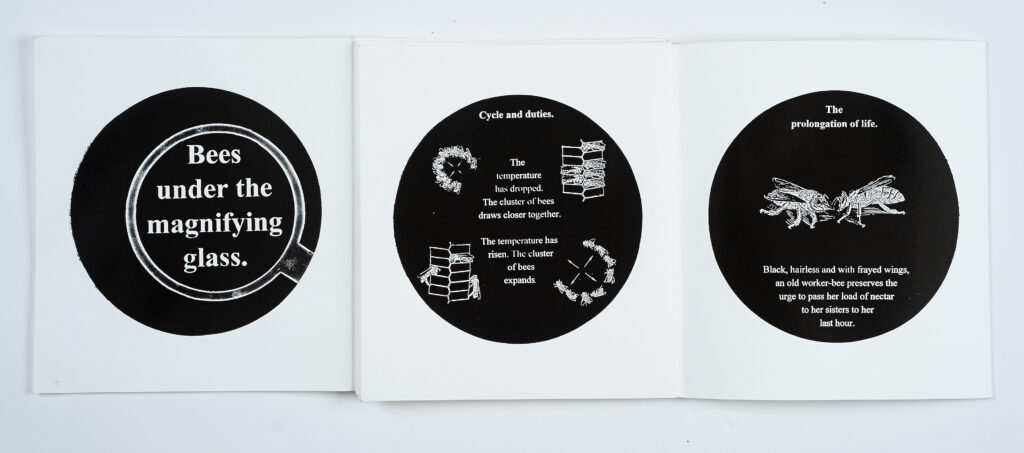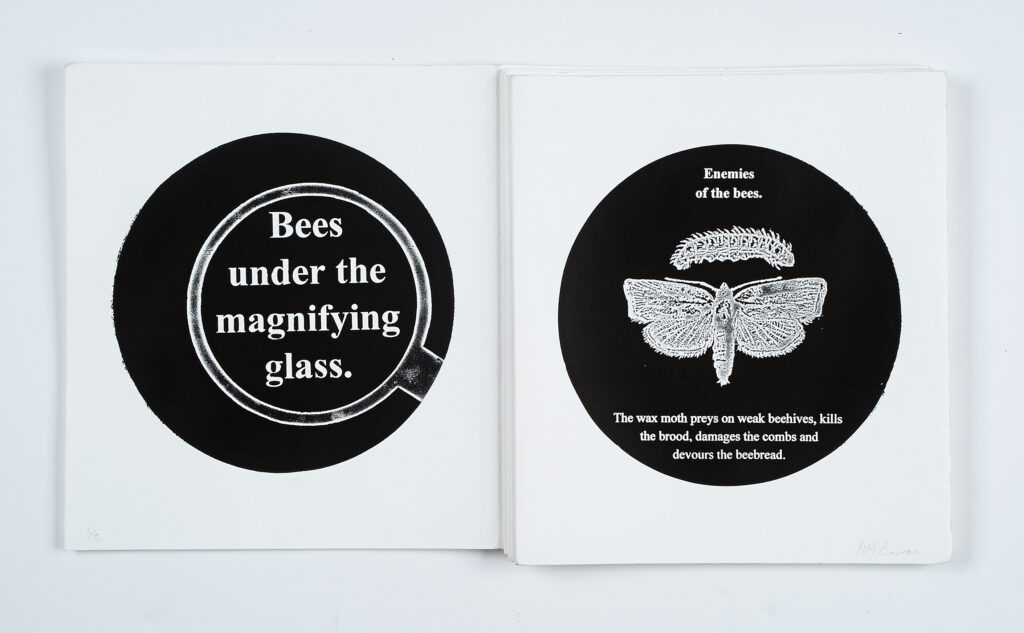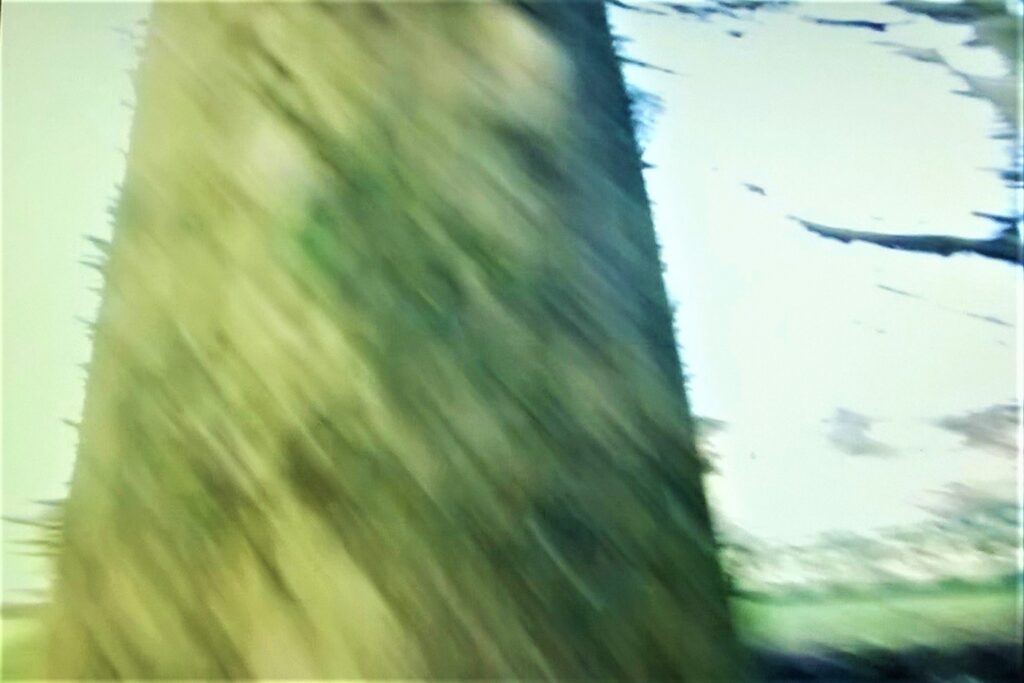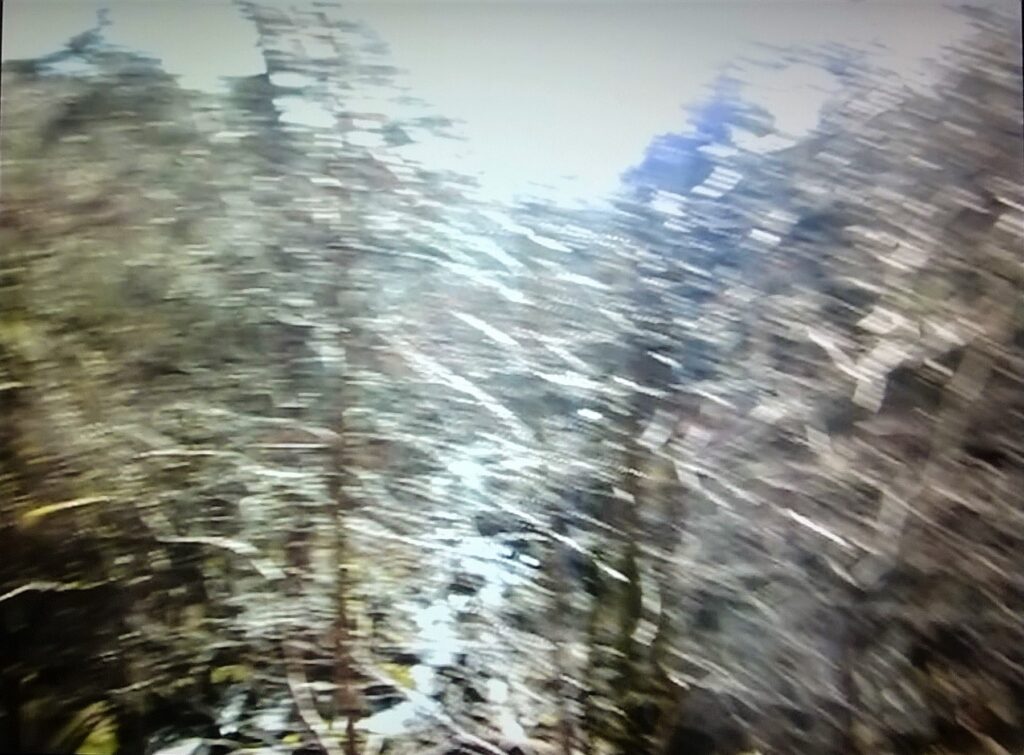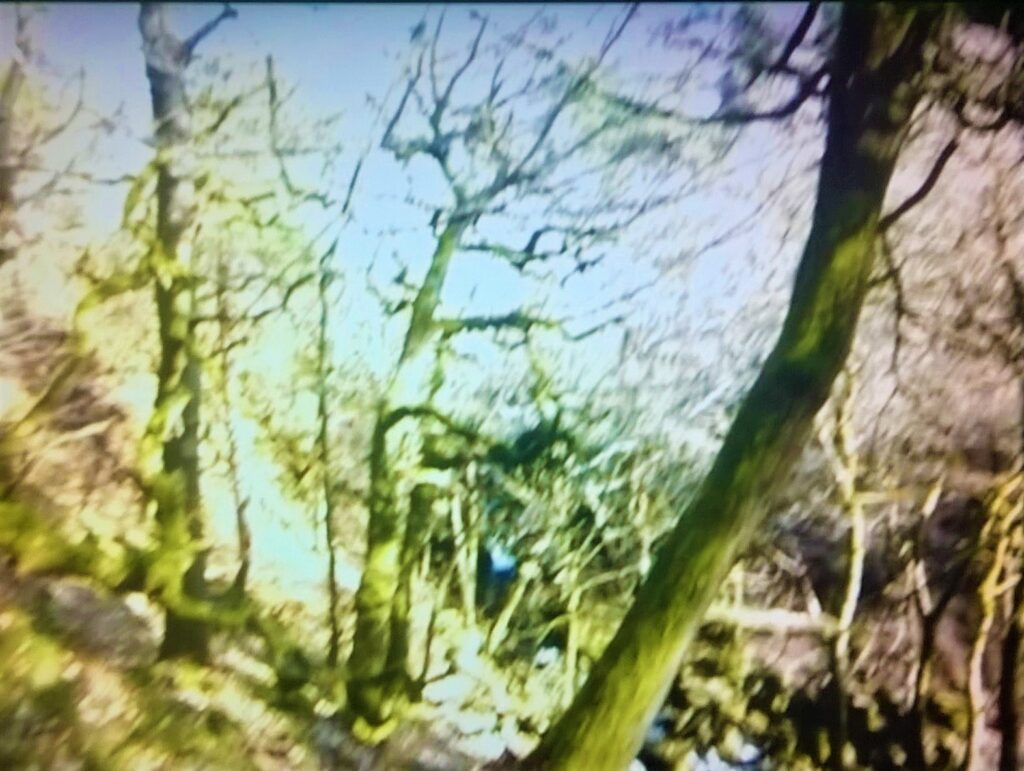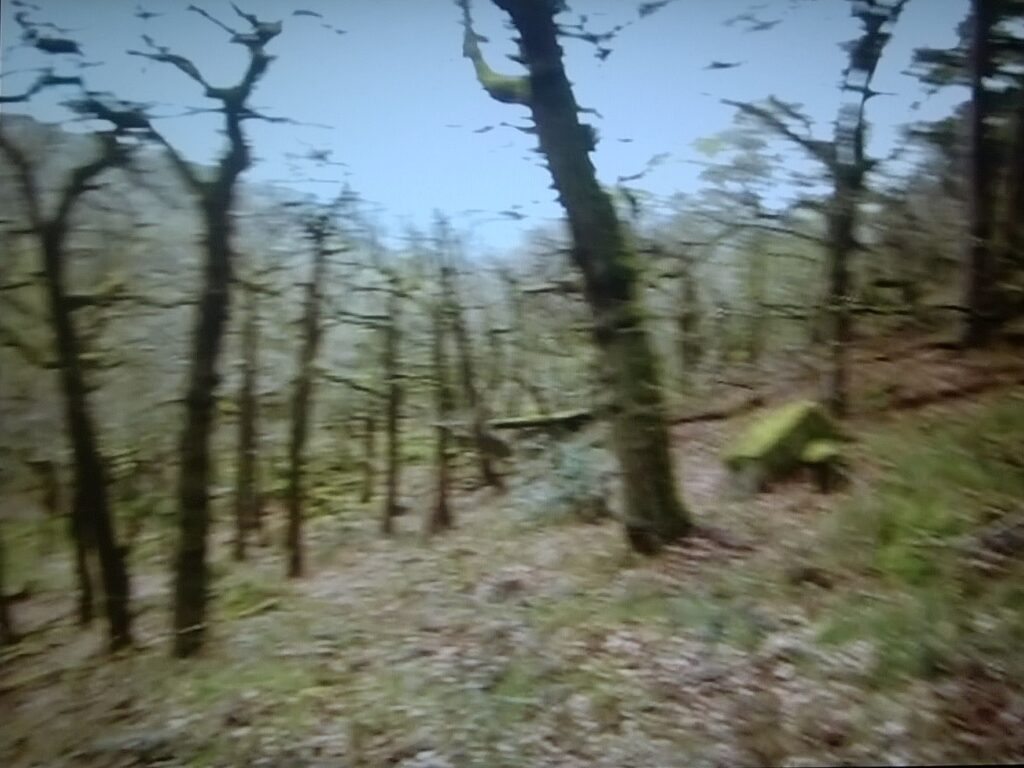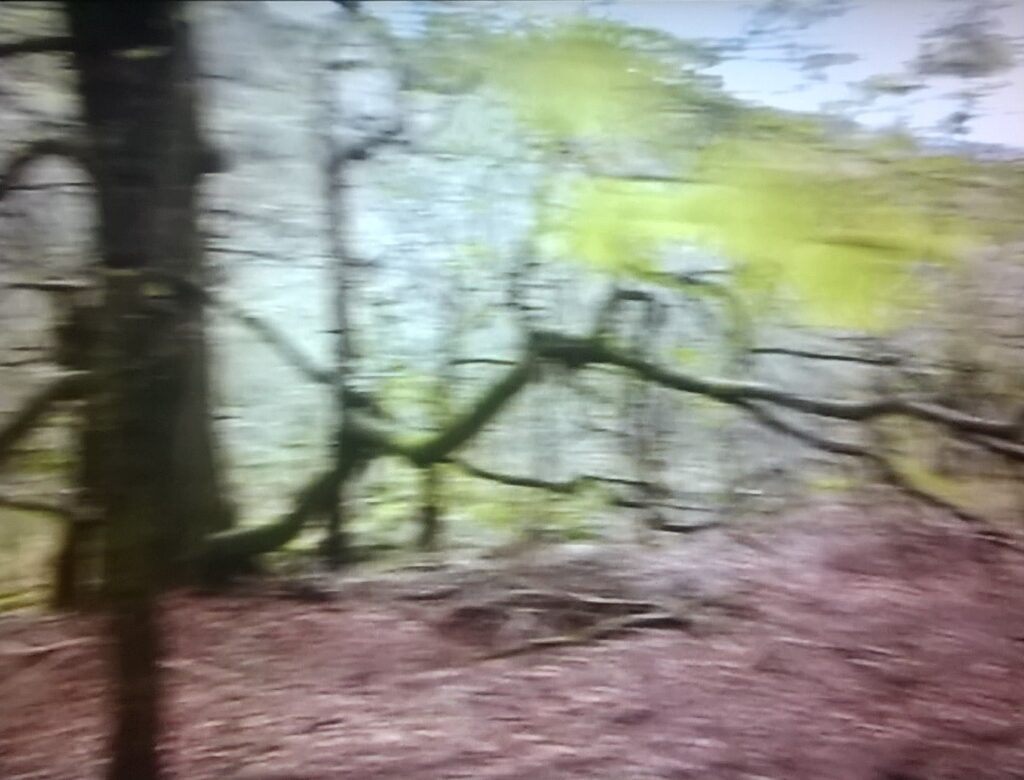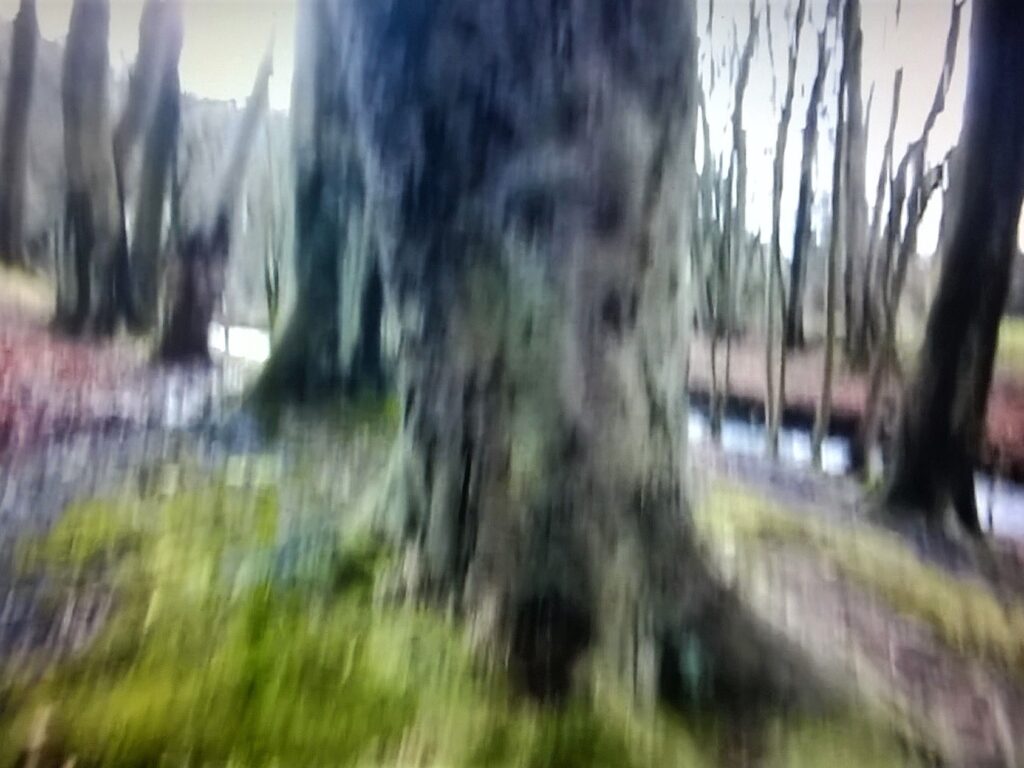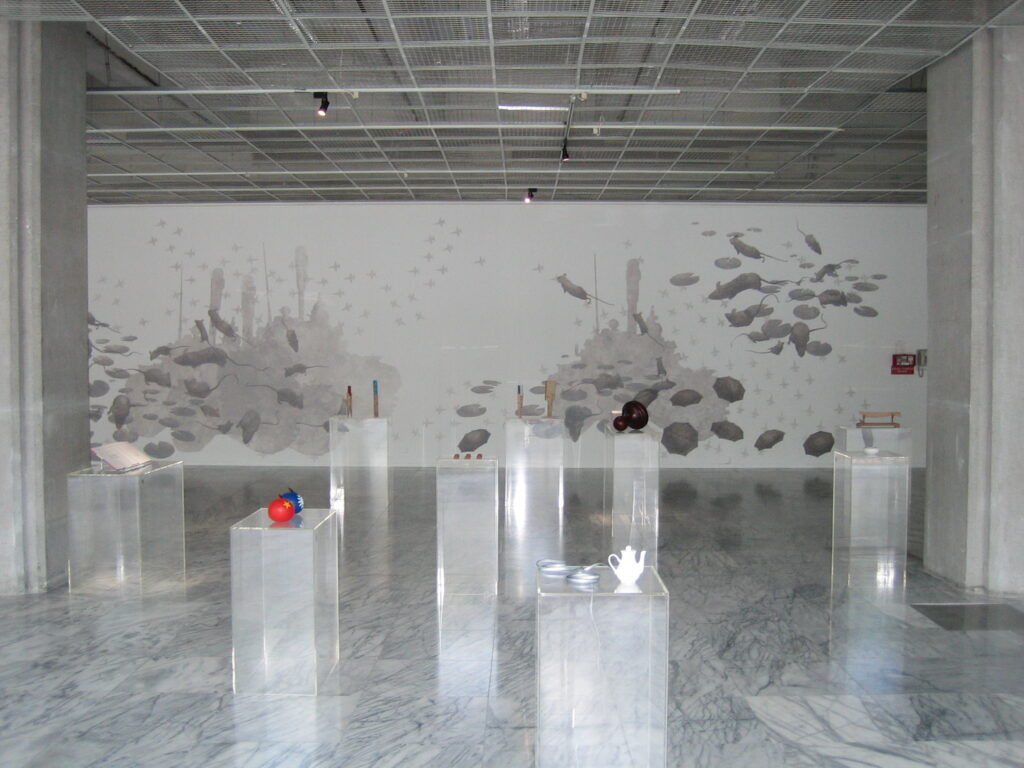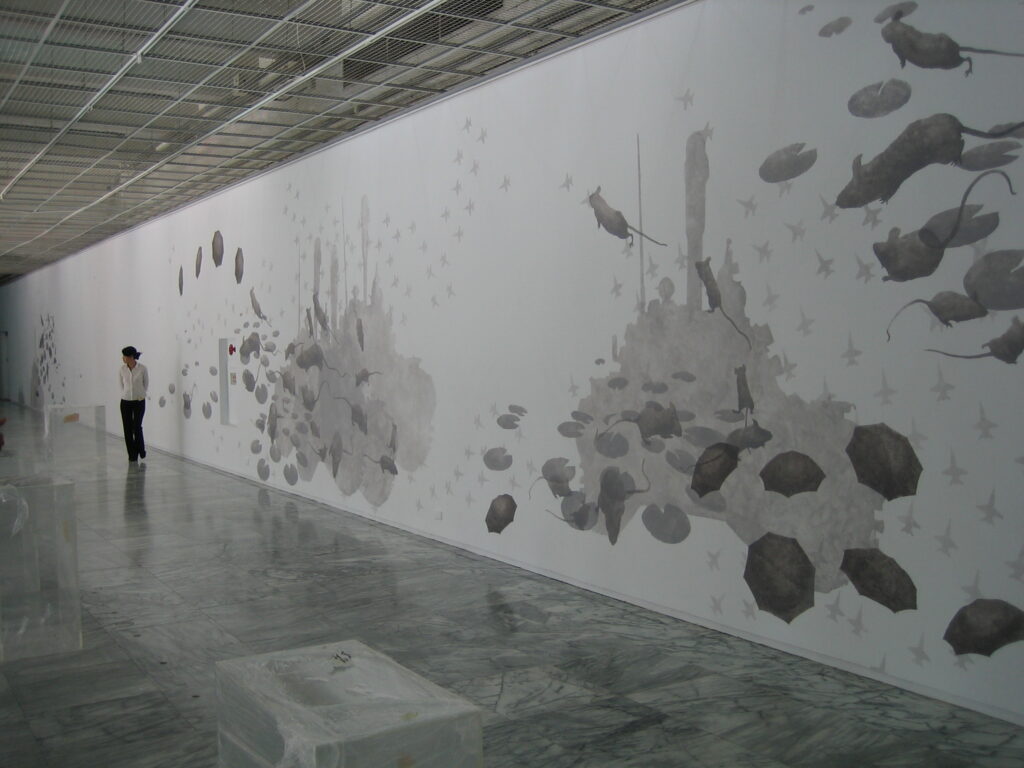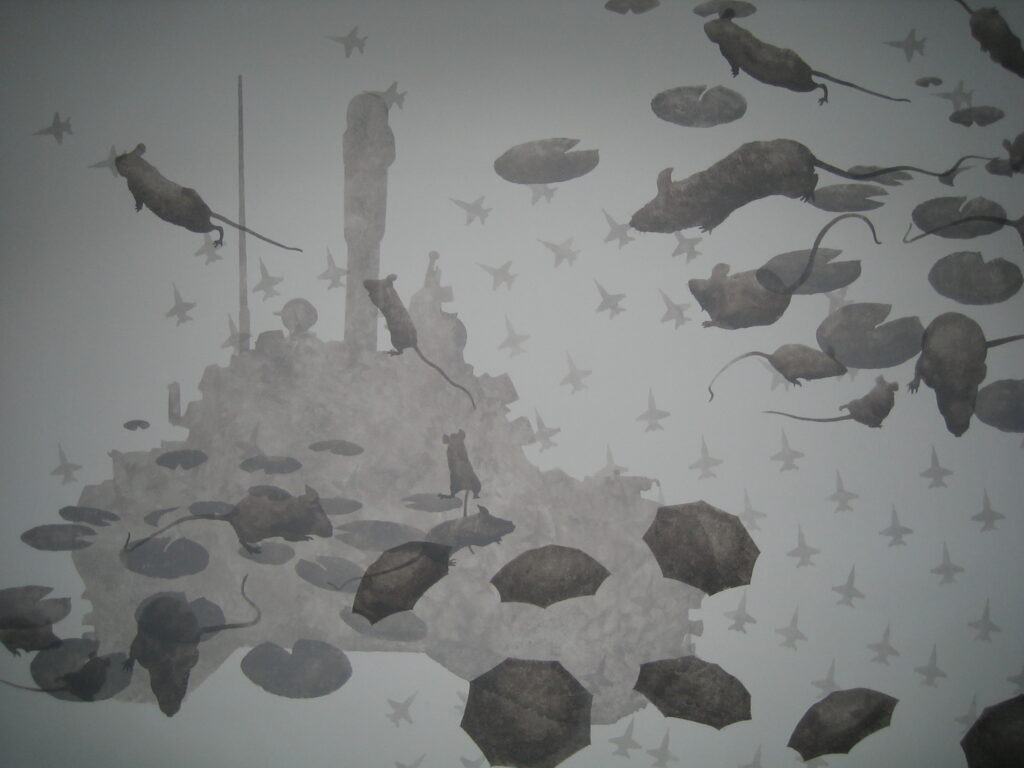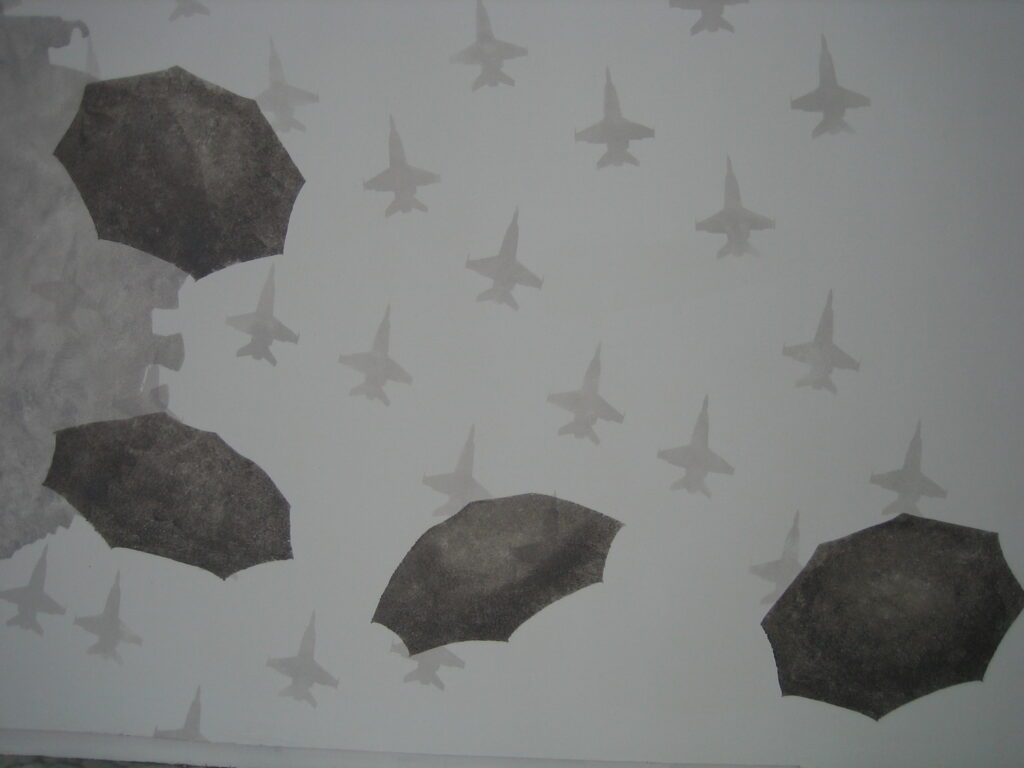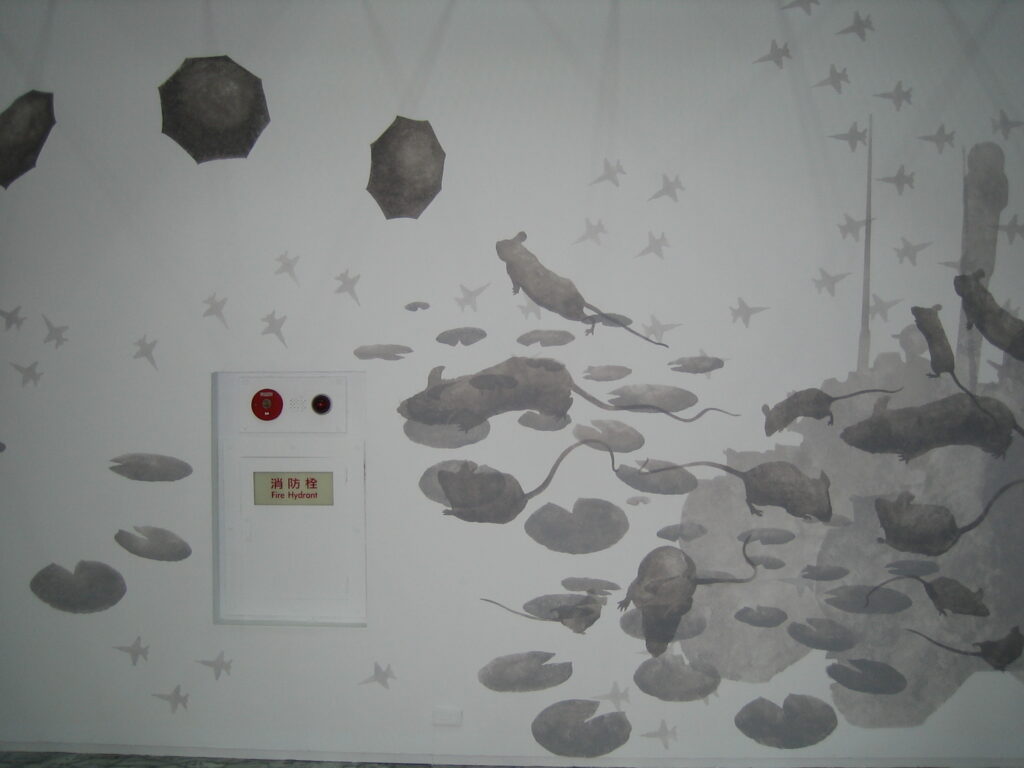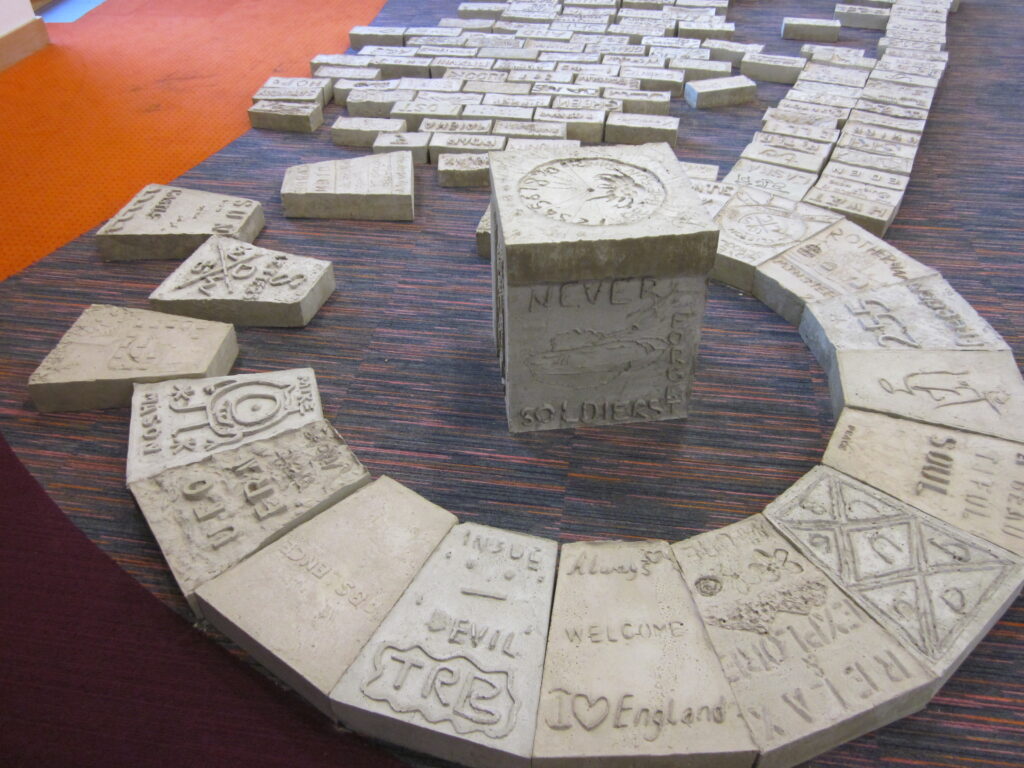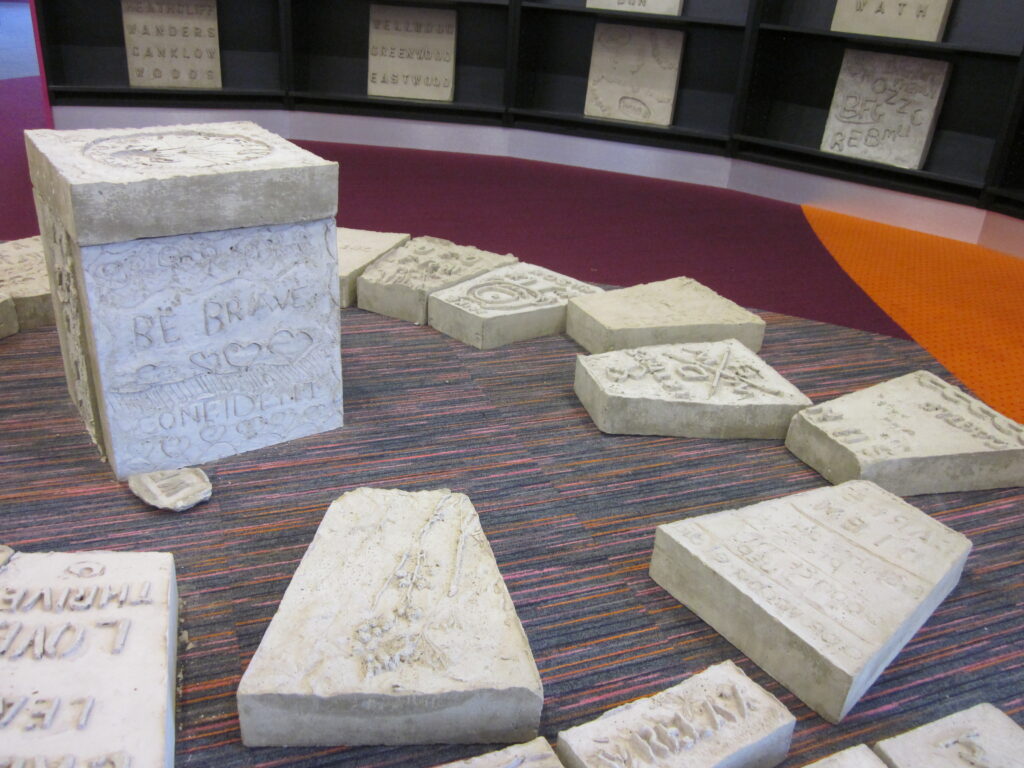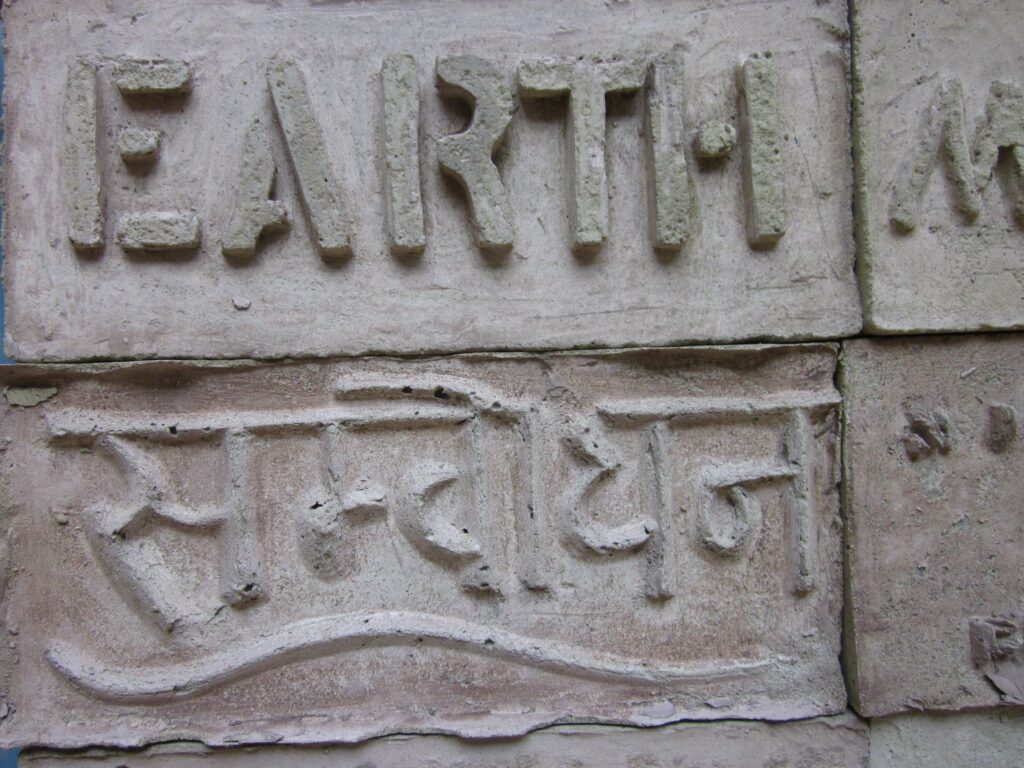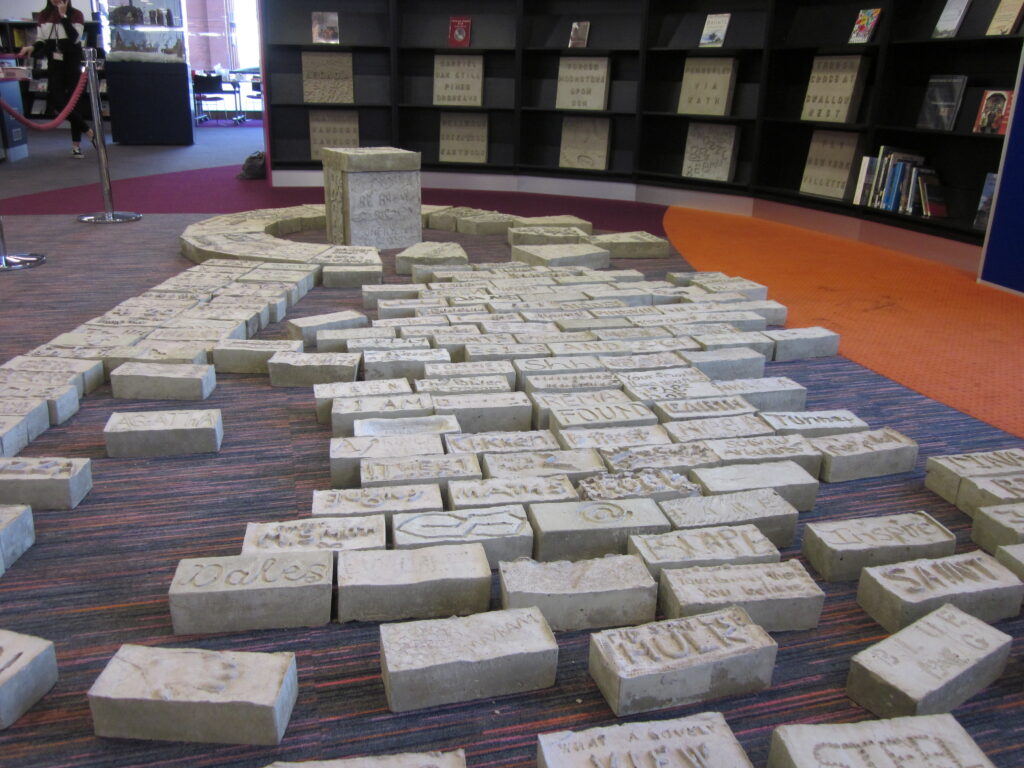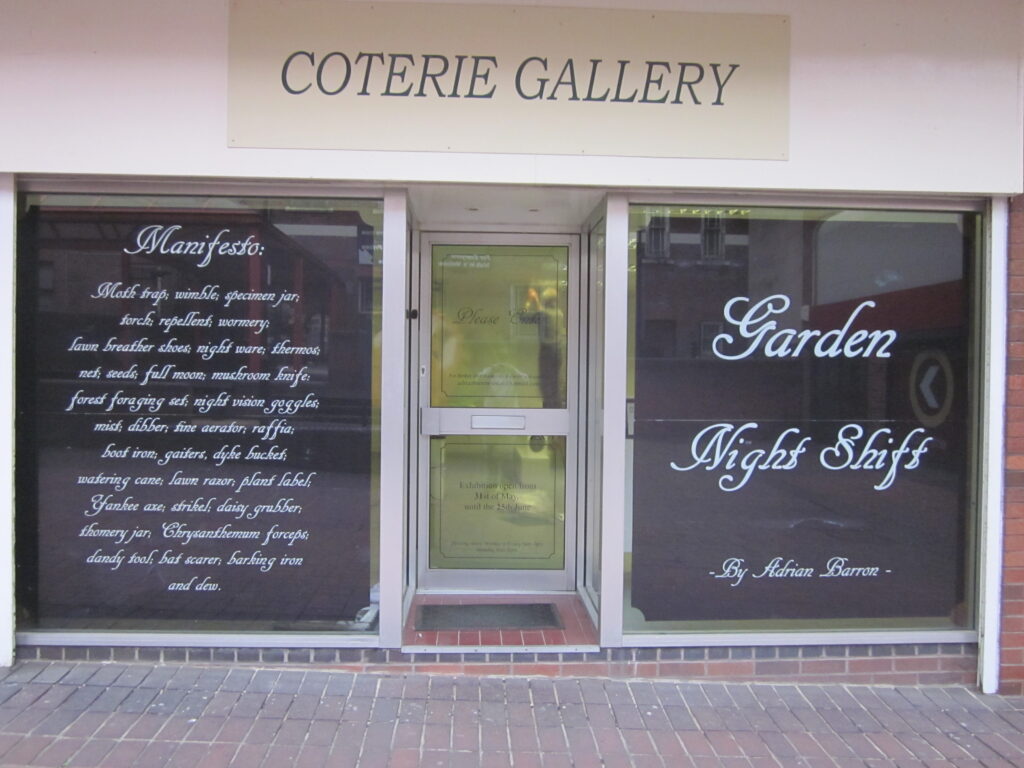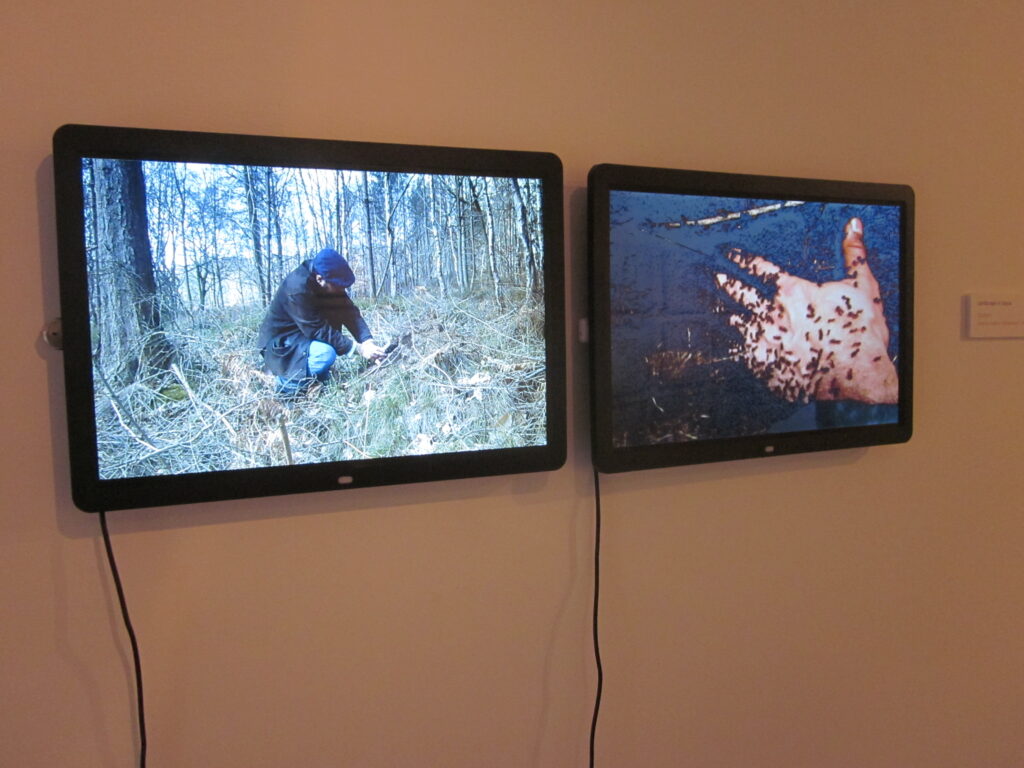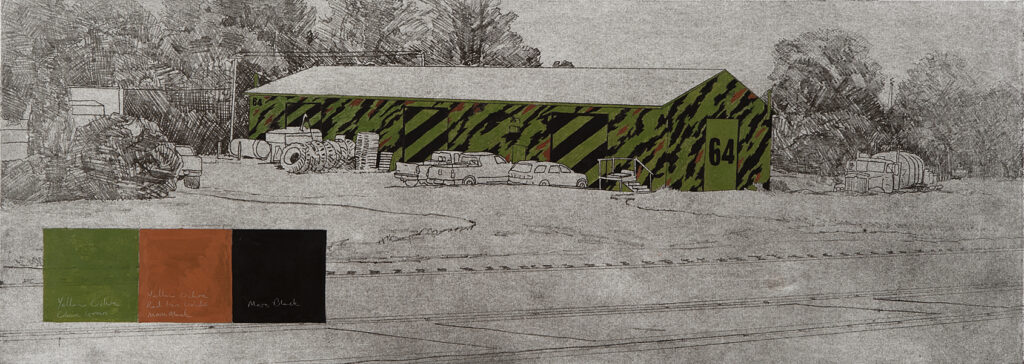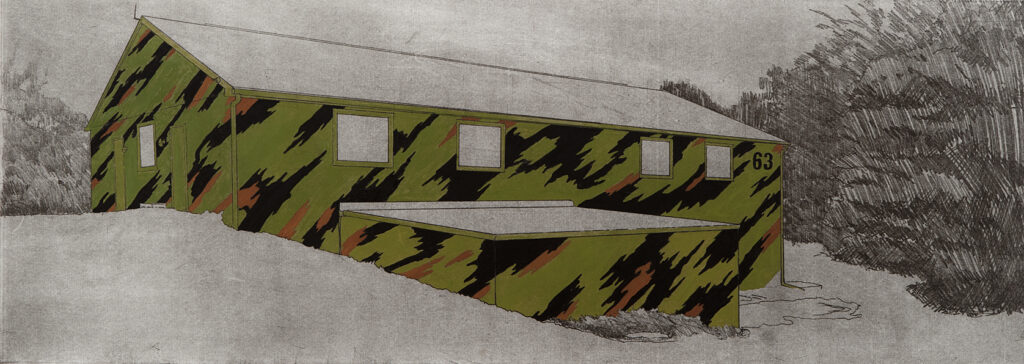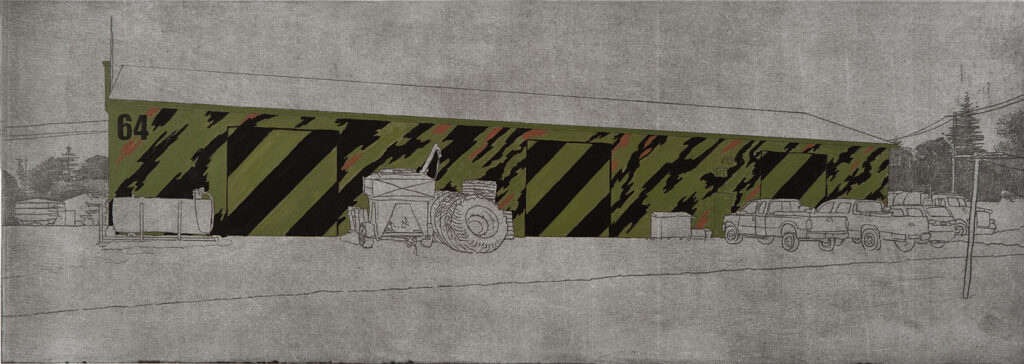FLORA & FAUNA
A day in the life of bombus
Wrexham Arts Centre, Wales. UK
Print – 150 soft ground etchings on steel.
Extract from the exhibition publication: The second major series in the exhibition A day in the life of Bombus, comprises imprints of insects culled from Barron’s own garden. The insect world has been ransacked and recorded. Each body has been pressed into cold metal and warm wax making an impression with their bones (chitin) and viscera. Acid has been poured into the wax cast to etch the otherwise bare metal surface recording this information in the steel. Ink is added leaving inky trails on the surface paper. There are no good and bad guys. The slugs, snails and spiders have an equal position with the bumble bees and butterflies and ladybirds. All are equal in Barron’s garden world. Each little death is numbered, suggesting the possibility that there are more to come. This is calculated killing which seems to hold itself out for analysis. It is like a pseudo scientific experiment from the Victorian era which is totally out of control.
Tim Davies
danse macabre
Landscape/ Nature. Kettering Museum, Kettering. UK
Slide projector – 30 images on a digital loop.
Interpretation from exhibition: Reconsidering the still life from the perspective of a nocturnal subject.
The fungi hold a unique position in the classification of species and otherness; food/poison, life/death, night/day. These photographs were taken during the full moon in a forest in central Sweden.
Hiawatha
Museum of International Art, Badajos, Spain.
Installation – Multiple, hand-carved sculptures from Gumbo limbo (Central American soft wood), water, and plastic crates.
The Project: Whilst working on an artwork in the Dominican Republic, I picked up a tourist trinket; hardwood carved wooden frog.
The proposal: to create a natural event within a gallery space, 250 frogs were carved using a tourist trinket of a frog as the template. Carving took place at Chichen Itza, Mexico by local indigenous craftsmen.
Rain followed by frogs, common in Central America; but high up in central Spain unheard of; In fact, frogs are traditionally considered bad luck in Spain. From the indigenous nations of Central America who have never forgotten the Spanish regime, please accept this gift.
Imperial Measures
Installations. Centro Iberoamericano de Formacia, La Antigua, Guatemala
Installation: illegally felled Cedar log cut into imperial sizes, rubber stamped with country of origin , shipped.
Originally when I was first asked to make an installation for an exhibition in Guatemala, I believed it was an impossibility; due to the logistics i.e. living in the UK. After discussions over the Internet with Yasser Musa of the Image Factory, Belize, it became feasible. With the instructions….”get a cedar log, illegally taken from the forest because it would be cheaper.” Like all of the first world I had come to the third, to get something for nothing “would it be possible to buy a log, without a care for the local inhabitants or the environment. It didn’t matter anymore whether it was illegal or not. The probability was that this kind of thing was happening every day in the non western world, whether it was for cattle ranching, building a Dam or a factory, it was primarily about exploitation.
new finds from the southeast
Landings 5. Museum of the Americas, Washington D.C. USA.
Installation – Glass vitrines, readymade, reclaimed materials, paint, found and dissected insects.
Currently, the cities of Southeast Texas are home to one of the world’s largest and oldest refining and petrochemical centres. With this point in mind what sort of insect would an entomologist find in the region?
a lost rhino
Landings 8 TMFA, Taipei, Taiwan
Photo etching on PCB board
Interpretation from exhibition: Durer produced the first western image of a Rhino but not from observation but from hearsay of sailors. 500 years later with so few left in the wild, we look to the internet now, to view these almost ‘extinct’ species. (Taiwan at the time of this exhibition, was the lead innovator of microchip technology)
THE HUNT AND CAPTURE OF APOLLO
‘Gatherings’ by ROAR, Wentworth Woodhouse, Rotherham.
Film and photographic documentation by Sharon Gill.
Vladimir Nabokov, novelist, and lepidopterist at the Harvard Museum: hunting butterflies, – Oh my god. Look at that poise. That athleticism. That self-assurance. That spark of incandescent grace vibrating through his form. The lower lip lunging over the upper. The short pants.
Initial photography and filming took place in the Pyrenes mountains in France. The apollo a variable butterfly species, lives in isolated pockets on various mountain ranges from Europe to Asia. it is now close to extinction, as its rather unique mountain environment degrades due to climate change. This film harks back to a time when butterflies were in abundance and butterfly collecting considered the sport of the adventurer.
Nymph and satyr
Exhibition: NOF – Land, London
Statement: A transcription of a work by William- Adolphe Bouguereau called Nymphs and Satyr, a theme which has been used widely in European art and has its historical origins in Greek mythology. Barron’s video focuses on the interplay between man and nature, an all too often violent and ambivalent relationship. The site of filming is on the chilled shoreline of Kviby, Norway found inside the Arctic Circle on mid summers day. A place in which both subjects – Artist, and his femme fatale (Small Tortoiseshell butterfly) are both considered at the extreme of their endurance.

Flyer 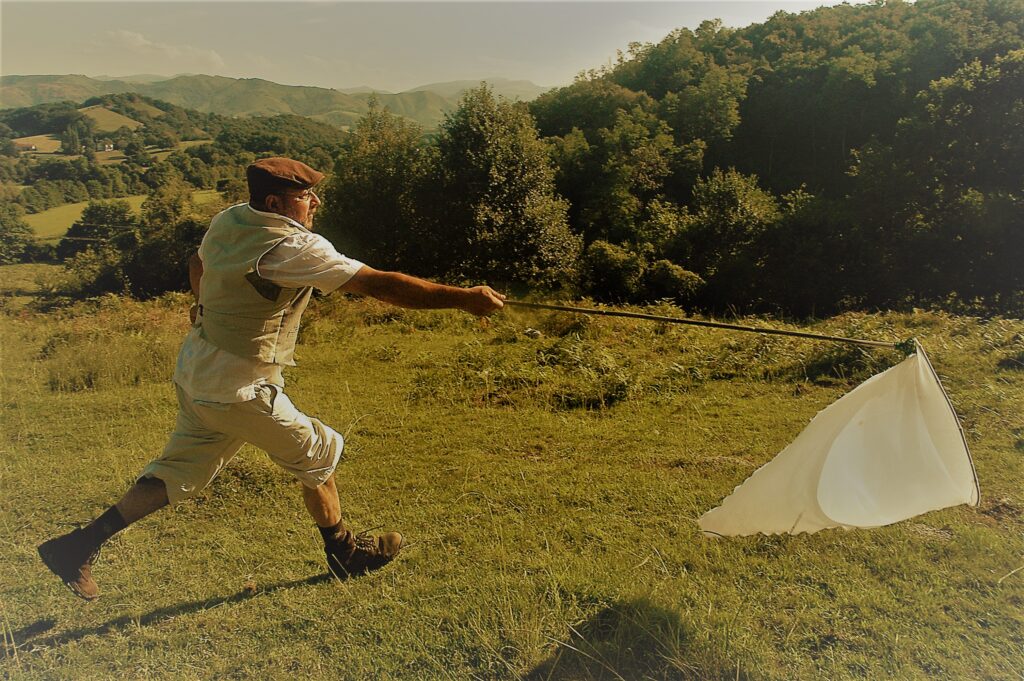
Charger 
Dropped 
Foil 
Whistle Jacket 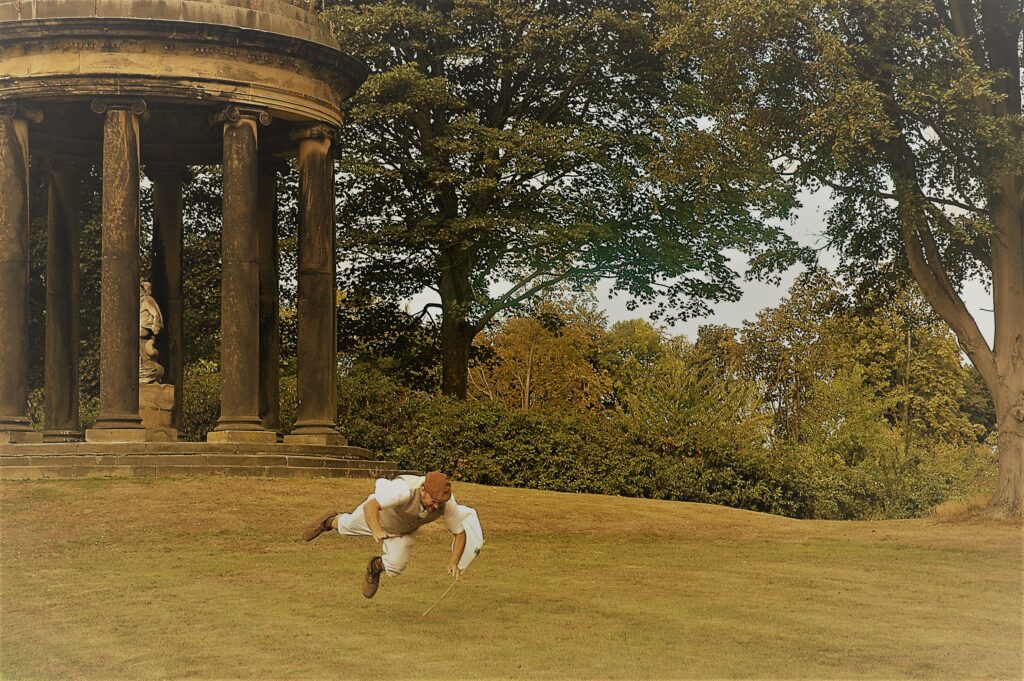
The Fallen 
levitation 
The Flag 
The captive
BEES UNDER THE MAGNIFYING GLASS
‘A Day in the Life of Bombus’,@ ‘No place like home?’ Spaceship, New Art Spaces Museum, Israel.
Hand printed relief prints – leporello book
Extract from exhibition – Barron’s book Bees under the magnifying glass is his negotiation of the cognitive dissonance he feels. It draws together in simplified terms the honey bee’s everyday life, but it is given a new sense of balance between external and internal influences, such as the bee keeper and the wax moth. They are found in balance at either end of the book.
Barron offers his audience a means of reading the actions of diminutive nature as metaphors, even lessons, to recognise the tragic circumstance of contemporary politics. The law of our jungle, it would seem, deliberately obfuscates our understanding of the nature of things. Through our confusion and ignorance we are dumb to respond and collude through our silence.
forest
Cathedral project
Cathedral Project. Poustinia Earth Art Park, Belize.
I conceived an installation known as the “Cathedral Project.” This involved the planting of a variety of indigenous tree species from Belize. They were planted to the dimensions of Westminster Abbey, in an environment surrounded by Maya mounds. 250 saplings were planted. The whole project will take approximately 500 years to complete.
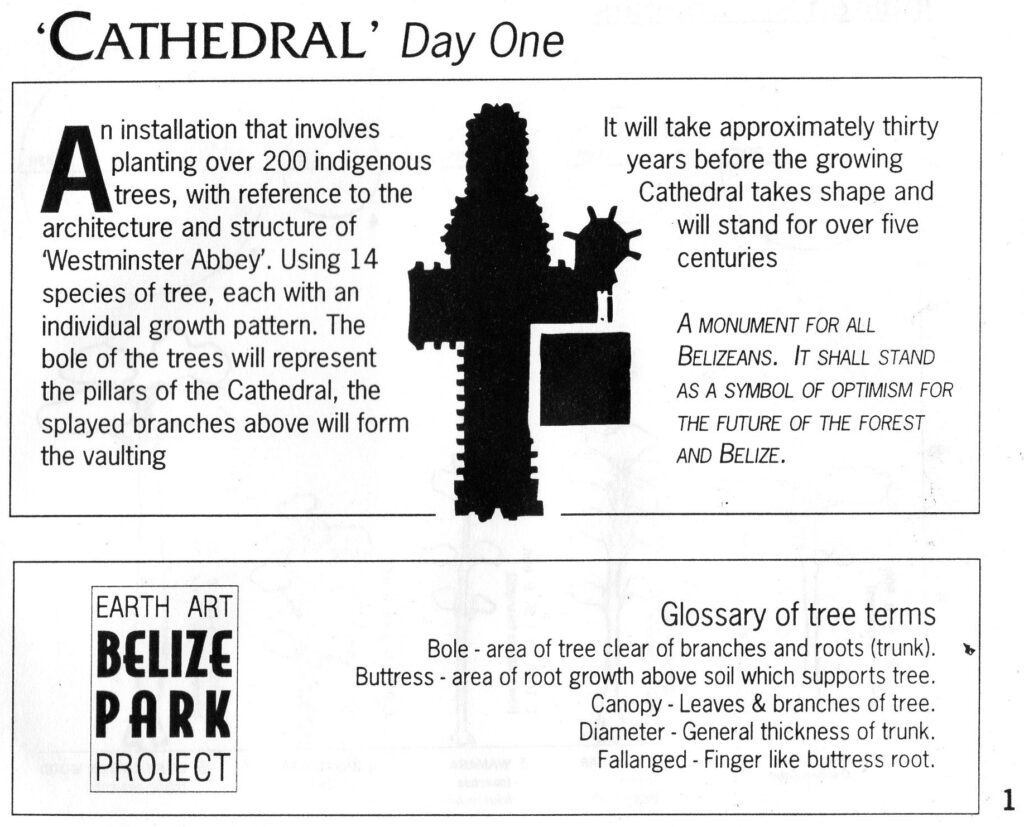


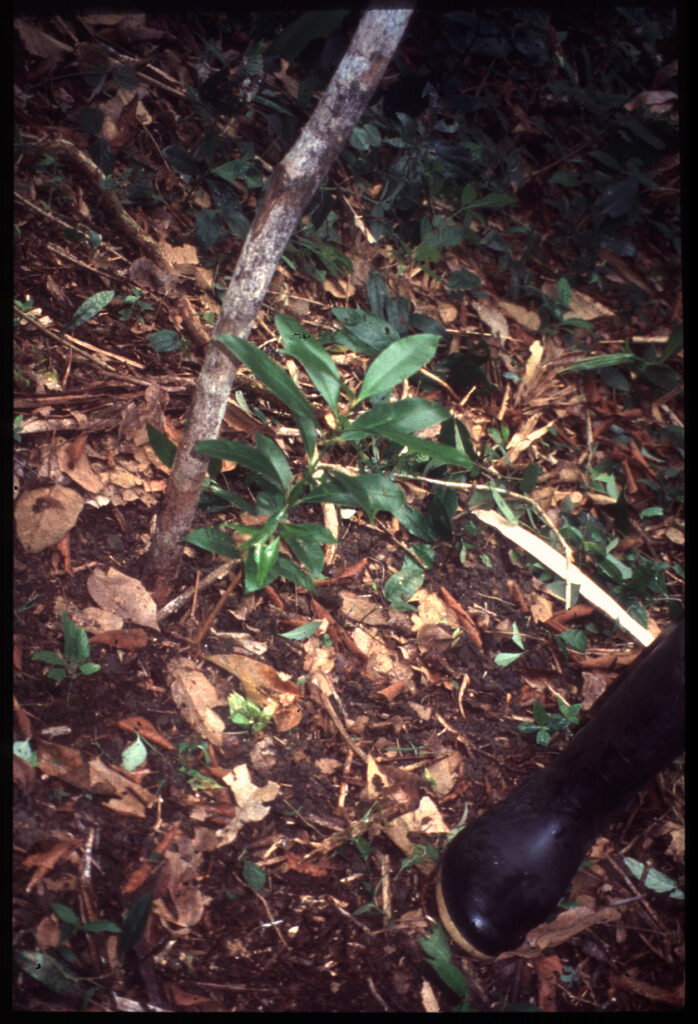
Rosewood sapling 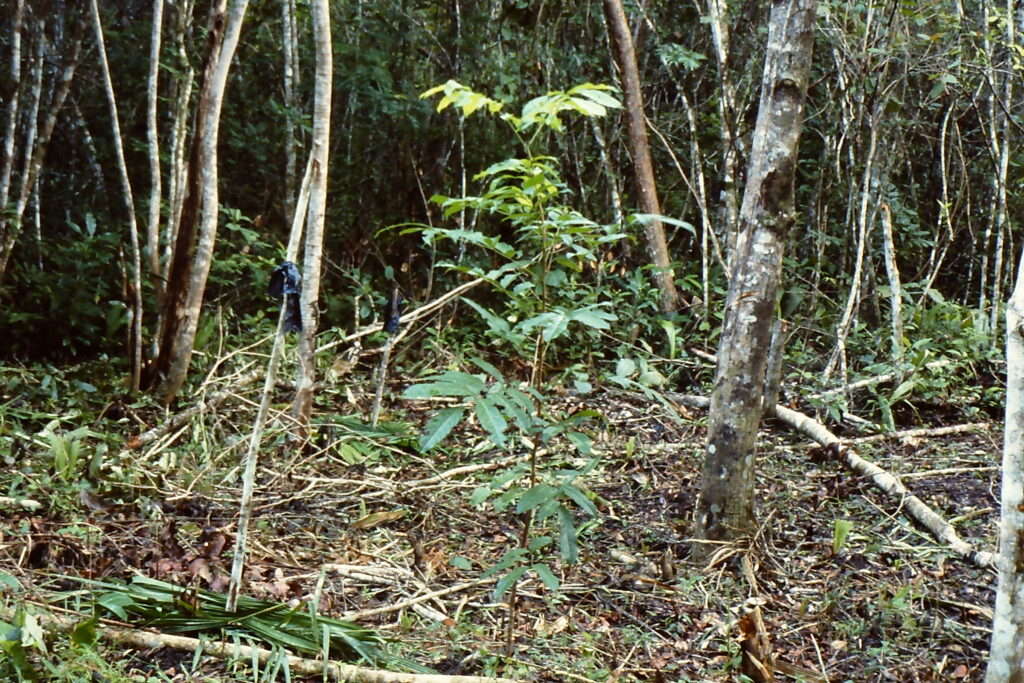
Mahogany after one year 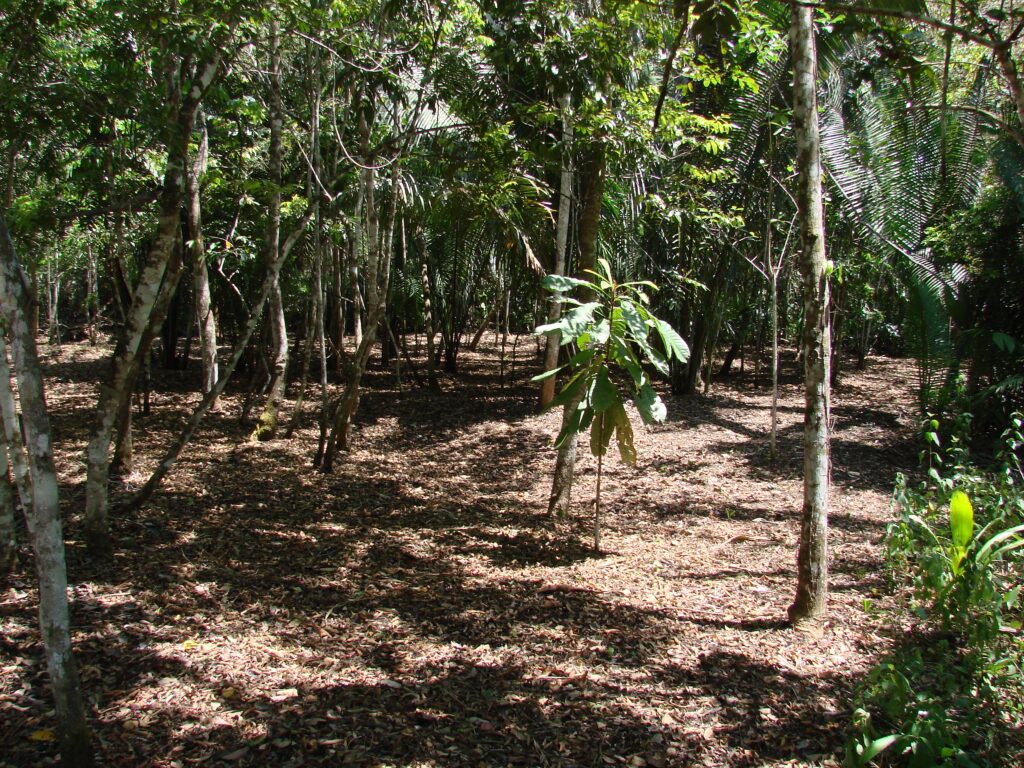
Cabbage bark after two years 
Mahogany after two years 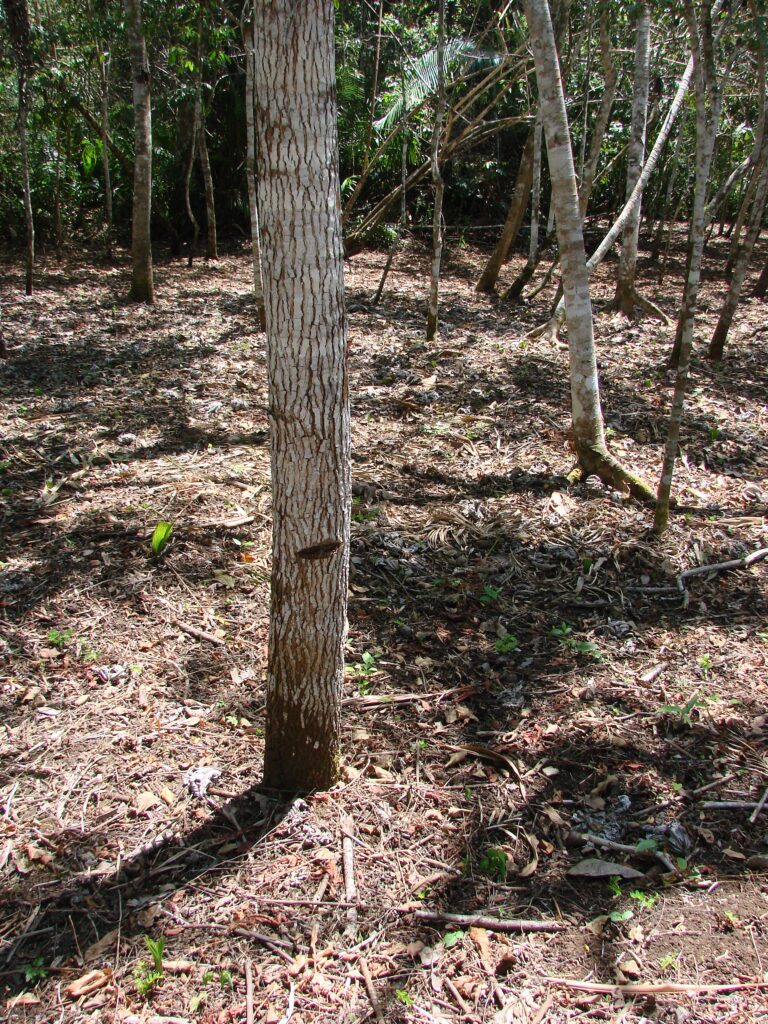
Cedar wood tree after ten years
NIGHT FOREST
Alfred East Museum, Kettering, UK.
Moving image, slide show, drawings, prints (in reference to Alfred Easts later prints)
Drawn Studies for a sequence of images of trees photographed at night, they flip over one after the other, an endless landscape in which tree and sky are only vaguely differing in the blackness of the night. You the observer are in fact the insignificant figure passing through.
Supervene Forest
Street Road Arts project, Pennsylvania, PA, US.
Site specific, community based project.
Project statement: Artist Adrian Barron planted 2,000 acorns collected from local ‘William Penn’ oak trees, at the intersection of Routes 926 and 41 on approximately one acre of Street Road’s site. The resulting work, an ongoing growing installation, is a unique intervention that prompts reflection on nature-culture dichotomies. Barron’s Supervene Forest is a site-specific work combining philosophical concerns central to his practice with Street Road’s unique context. He writes: “Parts of western Chester County retain a fading air of the rural idyll even as suburbs encroach, and the natural topography is altered. Urbanizing tendencies are reflected in and facilitated by developments to the region’s main arterial, Pennsylvania Route 41. Through the communal planting of acorns along the highway, we can create what I call an antipathy to this manmade disruption.” As an artist creating an event inspired by natural processes to supersede less ecologically sensitive manmade changes to the landscape, Barron also engages in contradiction that drives questions relevant to a world with rapidly changing climates. The word ‘supervene’ means ‘to happen unexpectedly in a way that interrupts, stops, or greatly changes an existing situation’. The Supervene Forest constitutes a living question about what kind of developments are desirable, and sustainable.
Emily Artinian
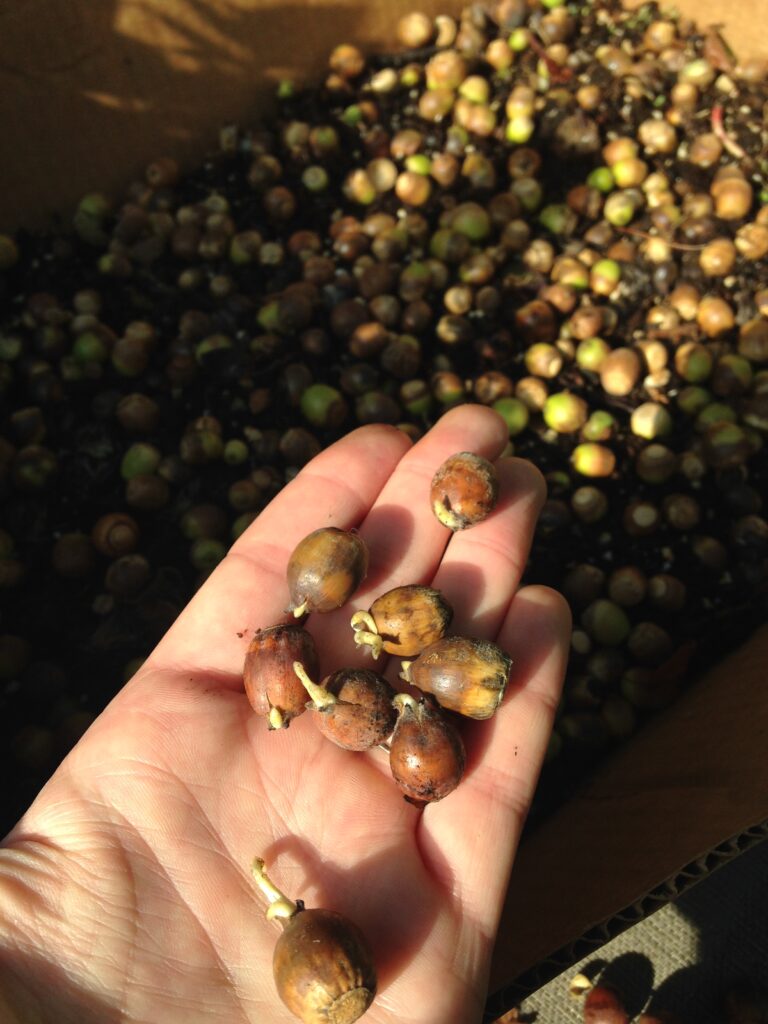

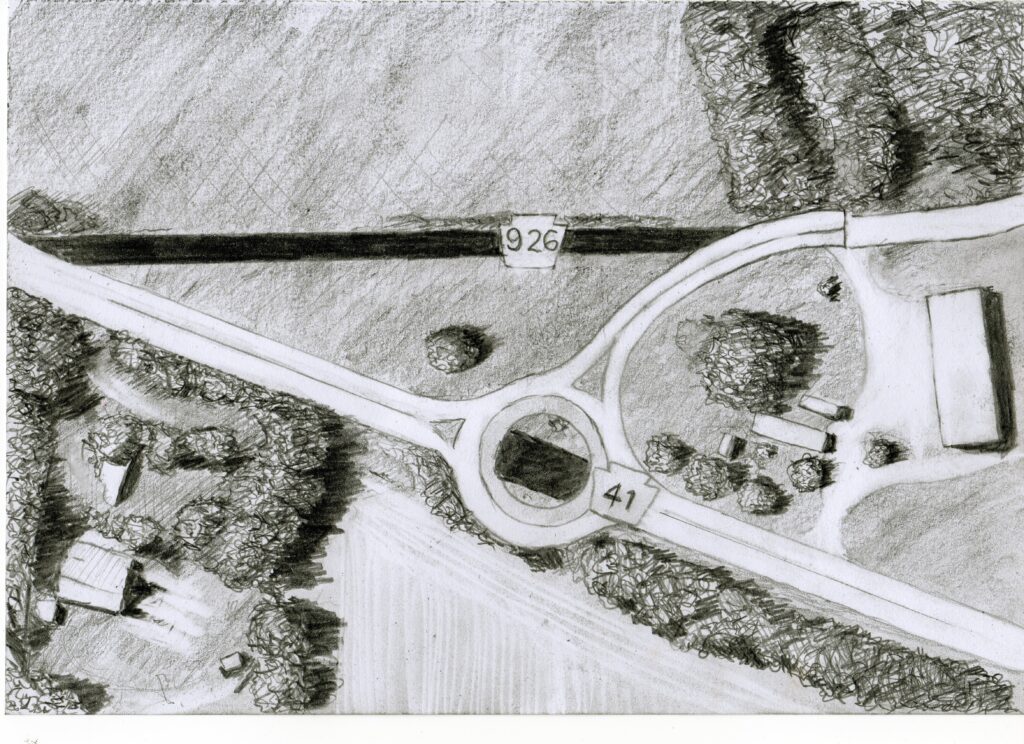
Proposed route of new road system 


Penn Oak 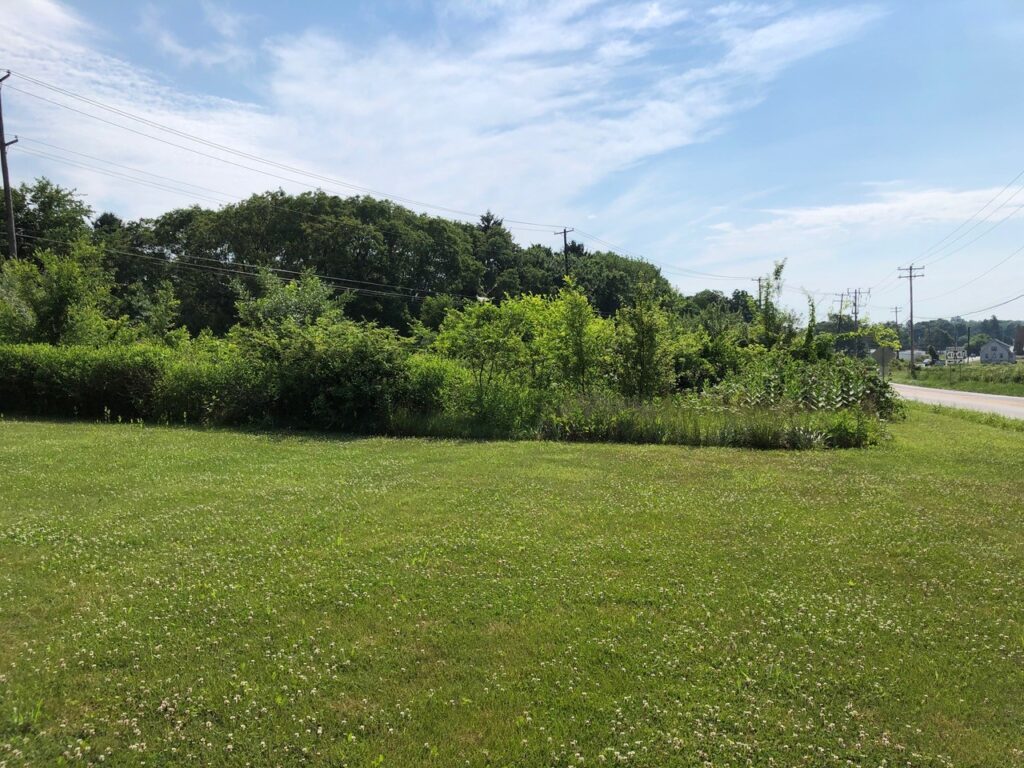
Supervene forest
PSITHURIsM CORDS – (WISPERINGS)
selected photographic stills taken from fast action short films, various site- woods forests and clearings.
Psithurism – pronounced sith-err-iz-um, the sound of trees moving in the wind. Peter Wohlleben in the book ‘Hidden life of trees’ suggests people consider trees to be static as if mineral; he says they are in fact moving and communicating, attached to the ground by an umbilici of roots and fungal synapsis, they forage, feed off the fallen, exhale and assist there siblings and protect there children.
garden
CHA CHA CHA
Landings 8, TMFA, Taipei, Taiwan.
Stencil work, site specific, disruptive, collaboration, installation.
Extracts from exhibition statement: The title of this multi-layered mural suggests it is synonymous with the Latin dance beat infamous in the early 1950s. ‘Cha Cha Cha’ is also the staccato sound of the artisans paint loaded brush as it hits the wall through the silhouette of the handmade stencil. In Taiwan where this mural is being exhibited the sound actually means Tea Tea Tea.
The influences of ‘Cha Cha Cha’ are not that of the guerrilla tactic, political art on walls so often seen in the contemporary art market, or the ghetto graffiti art, fresh from the spray can of the teenage rebellions of the eighties. Its influences are from a more temperate era of the arts and crafts movement of the 1890s, such as Voysey, Macintosh, and Klimt.
The multiple today exists in a state of similar order whether it is a traditional etching within the confines of suite of prints, Laura Ashley patterned wallpaper or bake bean tins on a supermarket shelf. The eclectic combination of objects used in ‘Cha Cha Cha’ cannot be found within this traditional order, although they are all in fact from the same stable.
They each in their own natural habitat defy conformity. This is the very reason for my selection of motifs; these multi layered images are rhizomes. They defy reason, in the very nature that they spread grow and multiply.
CONCRETE GARDEN
Riverside Library, Rotherham.
Sand cement castings, disruptive, Artist collaboration – Shelagh McCarthy, installation.
Extract from proposal: The metaphoric language of the garden propels fiction, poetry, and dramatic narrative and the literary canon abounds with both manicured and wild gardens from Gilgamesh to Shakespeare, Frances Hodgson Burnett to Ian McEwan. In 2007 the Oxford Junior Dictionary took the decision to exclude a number of words including acorn, buttercup, adder, wren, and conker on the basis they were no longer in common usage and replaced them with words including attachment, block-graph, blog, broadband, bullet-point, celebrity, chatroom, voice-mail. Dictionaries rightly need to reflect the changes in our lives and language, but it is saddening to think that the natural world is being replaced by a purely technological one.
GARDEN NIGHT SHIFT
Garden Night shift. Coterie Gallery, Rotherham.
I set out a manifesto of words which you may use to navigate your way around the Garden Night Shift.
Manifesto; Moth trap; wimble; specimen jar; torch; repellent; wormery; lawn breather shoes; night ware; thermos; net, seeds; full moon; mushroom knife, forest foraging set; night vision goggles; mist; dibber; tine aerator; raffia; boot iron; gaiters, dyke bucket; watering cane; lawn razor; plant label; Yankee axe; strikel; daisy grubber; thomery jar; Chrysanthemum forceps; dandy tool; bat scarer; barking iron and dew.
HETEROTOPIA WEST
Street Road experimental art space, western Chester County, Pennsylvania
8 thematic plantings, each has a corresponding key essay, unlocking the concept of the garden.
The word ‘art’ can be replaced easily by the word ‘garden’. Art is about self-expression, about responding to your existence in this world. Ask any gardener about any plant in their garden and you will find a rational, and emotional, response to its existence. Sometimes this response involves a memory or commemoration; sometimes it involves a more abstract idea, such as a consideration of the relationship of one plant’s leaf to another plant’s stem. The gardener creates a three-dimensional living entity, full of an assortment of brush marks relating to texture, surface, colour, plane and thought. At times a gardener may portray a sense of place: referencing the Mediterranean garden, the English garden or the tropical garden. The gardener, like the artist, will not show you the garden, will not consider it ‘finished’, if not convinced of its aesthetic and conceptual significance.
Essays from the website http://www.streetroad.org/


Venus rising in all her glory 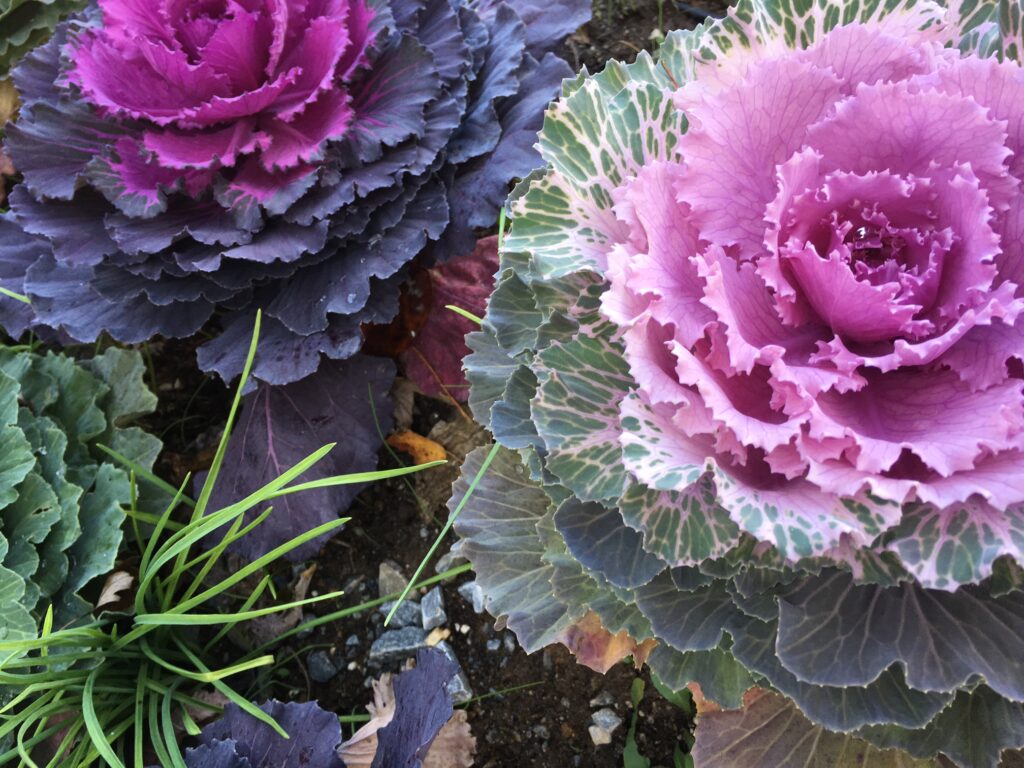
Venus rising in all her glory 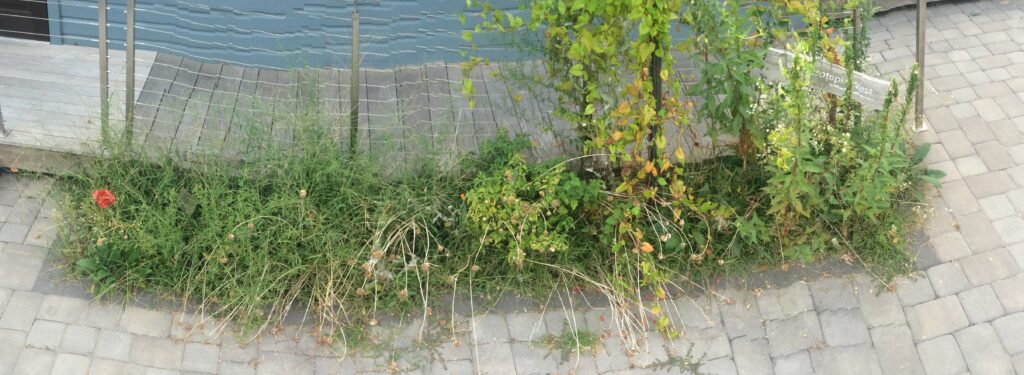
Invisible Gardener 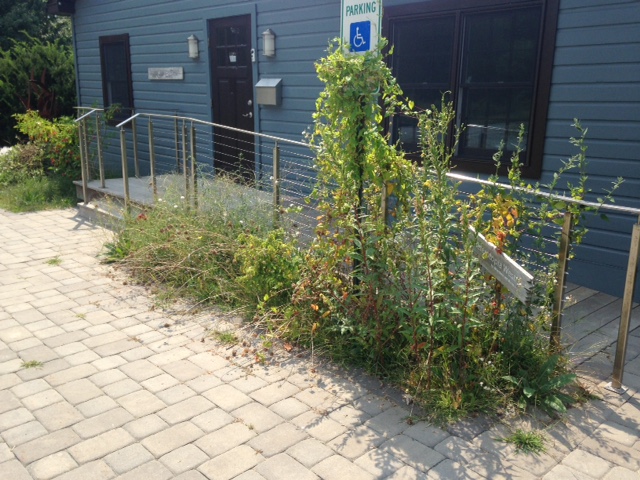
Invisible Gardener 
Invisible Gardener 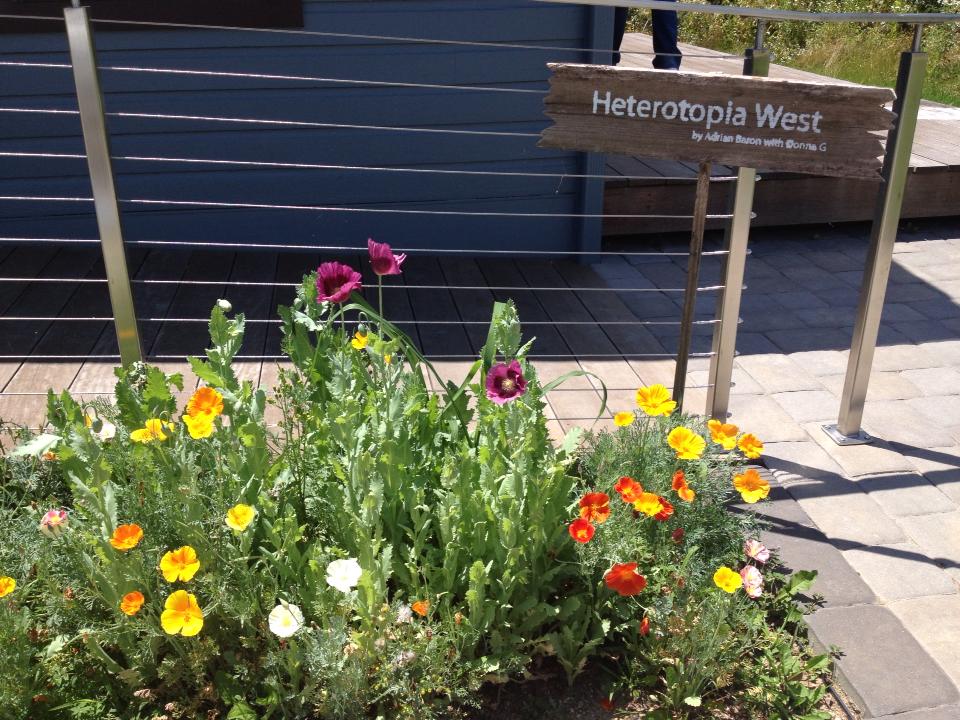
East meets West 
The three sisters 
It was a dark and stormy night 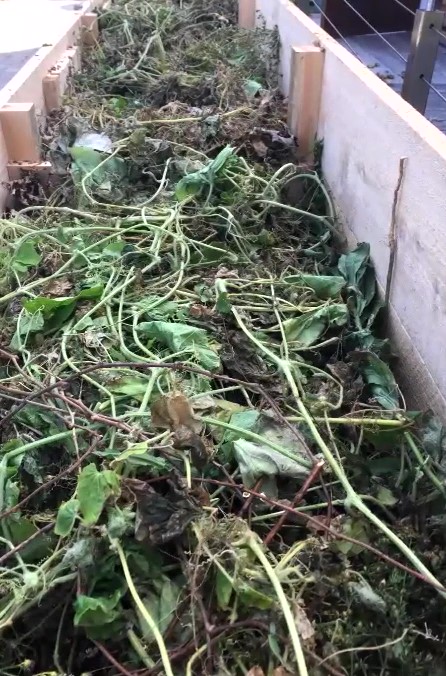
It was a dark and stormy night
New World Order
Museo de Arte Moderno, Santo Domingo, Dominican Republic
9m x 6m X Potatoes and sweetcorn
Statement from exhibition – Santo Domingo is the place at which Christopher Columbus first stepped ashore and the Old World discovered the New. This site-specific geopolitical world map created in the Dominican Republic, endeavours to divide the world into 76 kilos of hand printed X potatoes and 20 kilos of sweet corn, based on the proposition of the haves and the have nots. In so doing, it has created a new paradigm of world order.
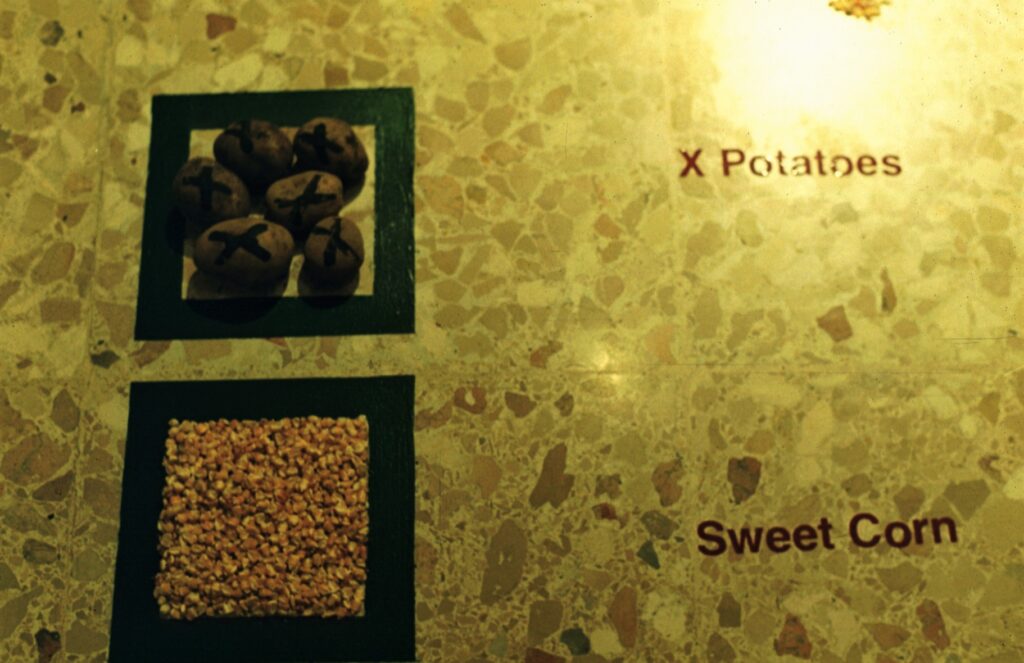
X Potatoes and Sweet Corn 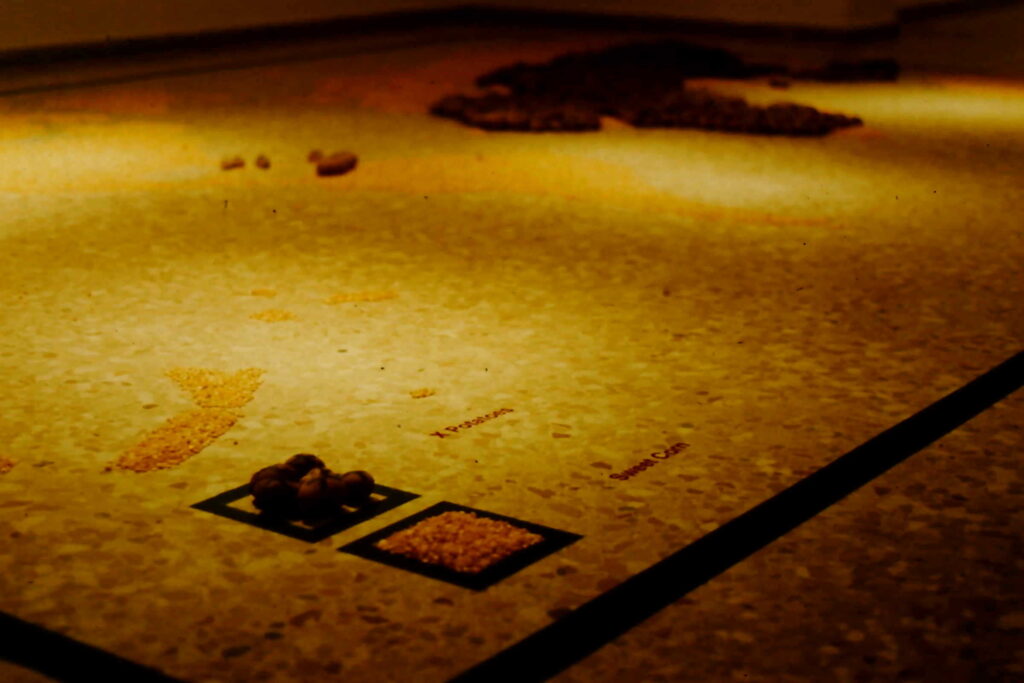
Geopolitical world map 
The Americas 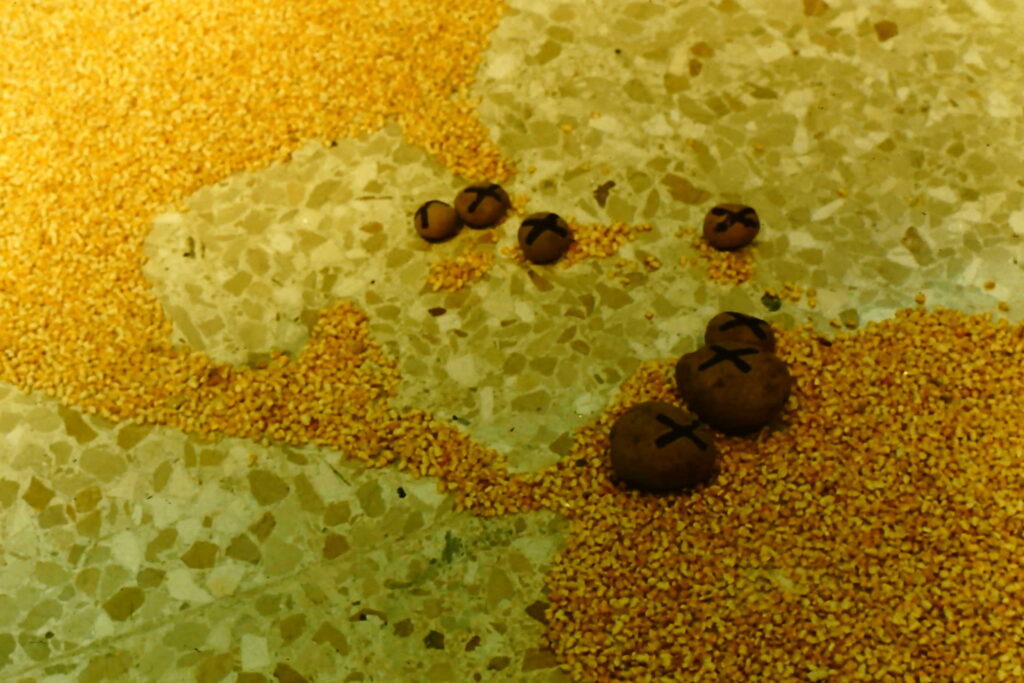
Latin America 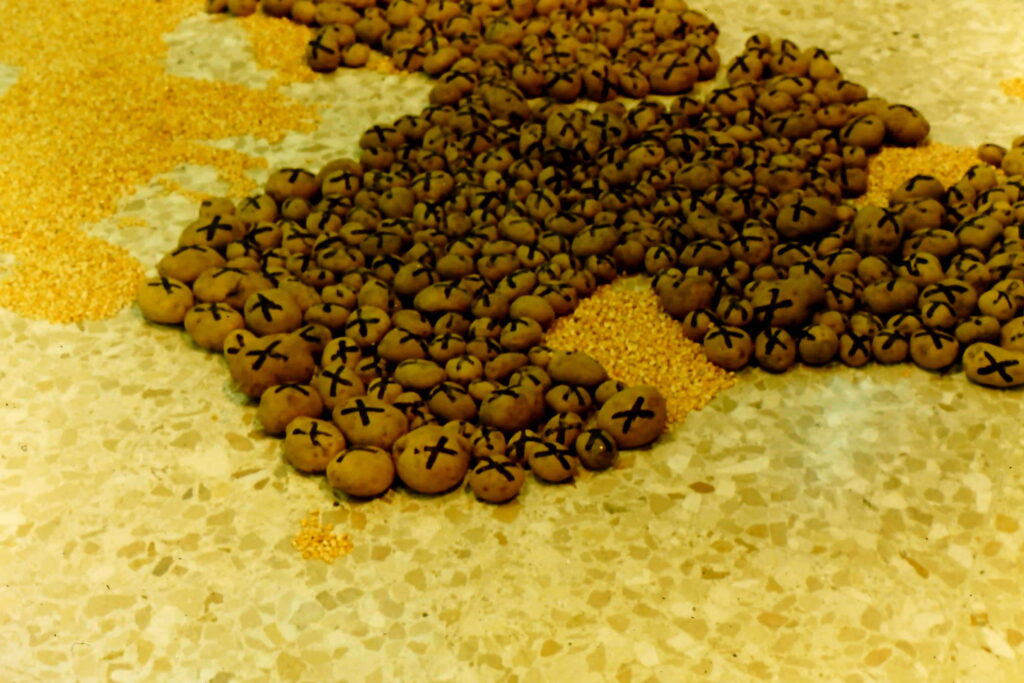
Africa looking East 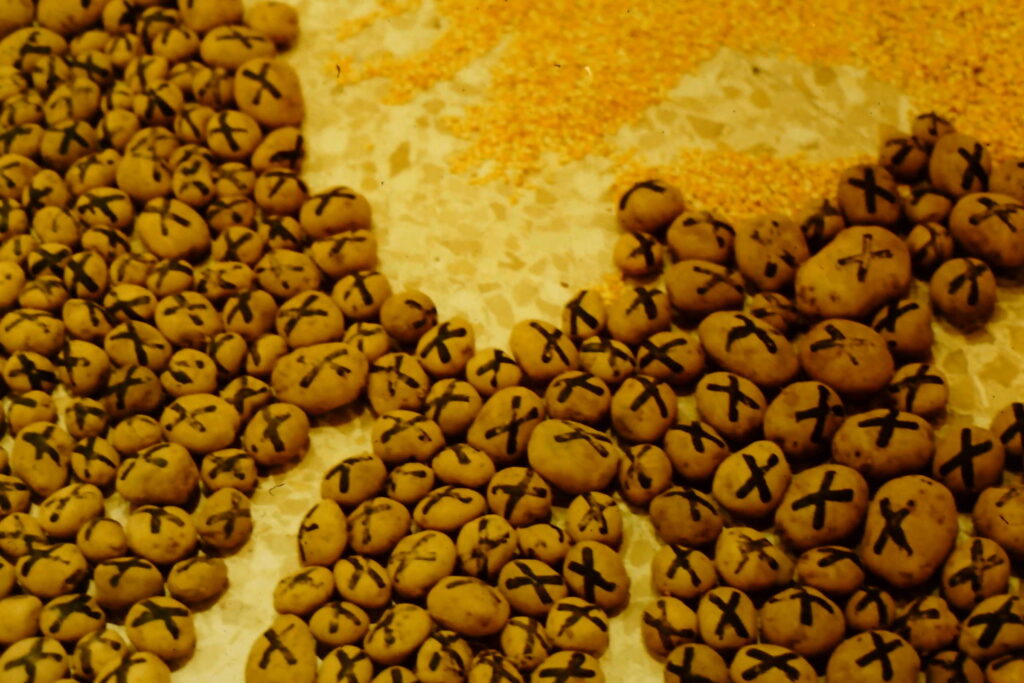
The Middle East 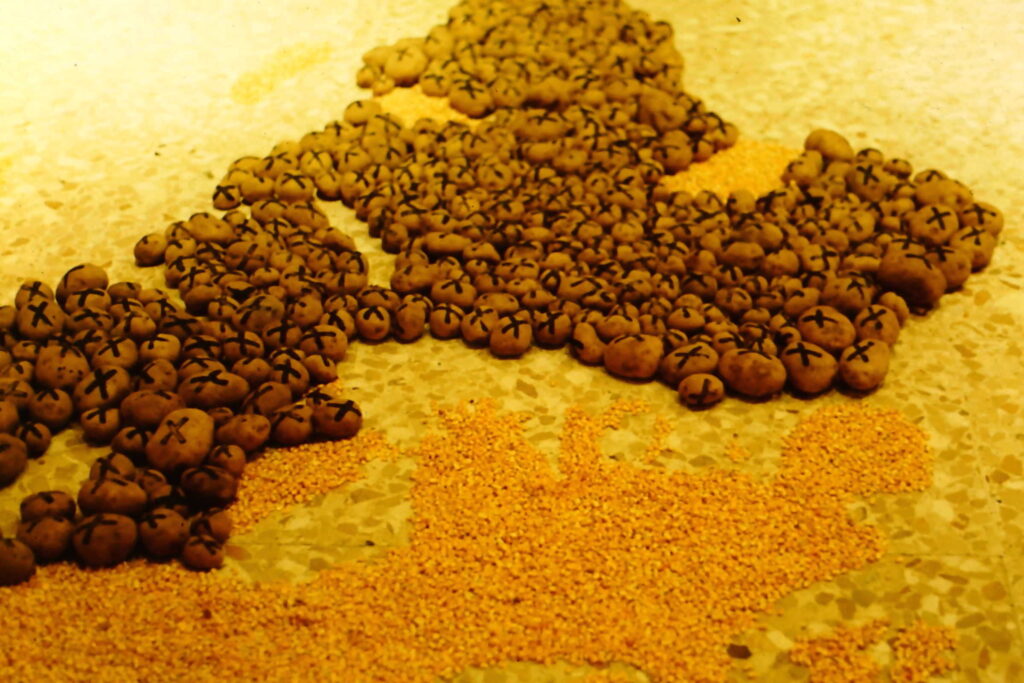
Europe looking South towards Africa
deception
Landings
Museum of the Americas, Washington D.C, USA
Technique: Large format etchings on steel.
Statement from exhibition: Implausible studies into camouflaging- The very nature of camouflaging is turning a solid object or space into the plastic so that its original identity and form are lost. In the case of these three-dimensional structures once camouflaged, seem to return to their original form.
From these visual studies I have deduced that the only plausible reason for armies to camouflage such vehicles is as placebo and comforter for the nervous occupants within. From the viewer’s standpoint, 50 tonnes of growling steel covered in stripes and spots probably promotes the same fear that our ancestral predators would have brought about.
Maybe it is just in the name, but the leopard 2 is the world’s most successful main battle tank today.
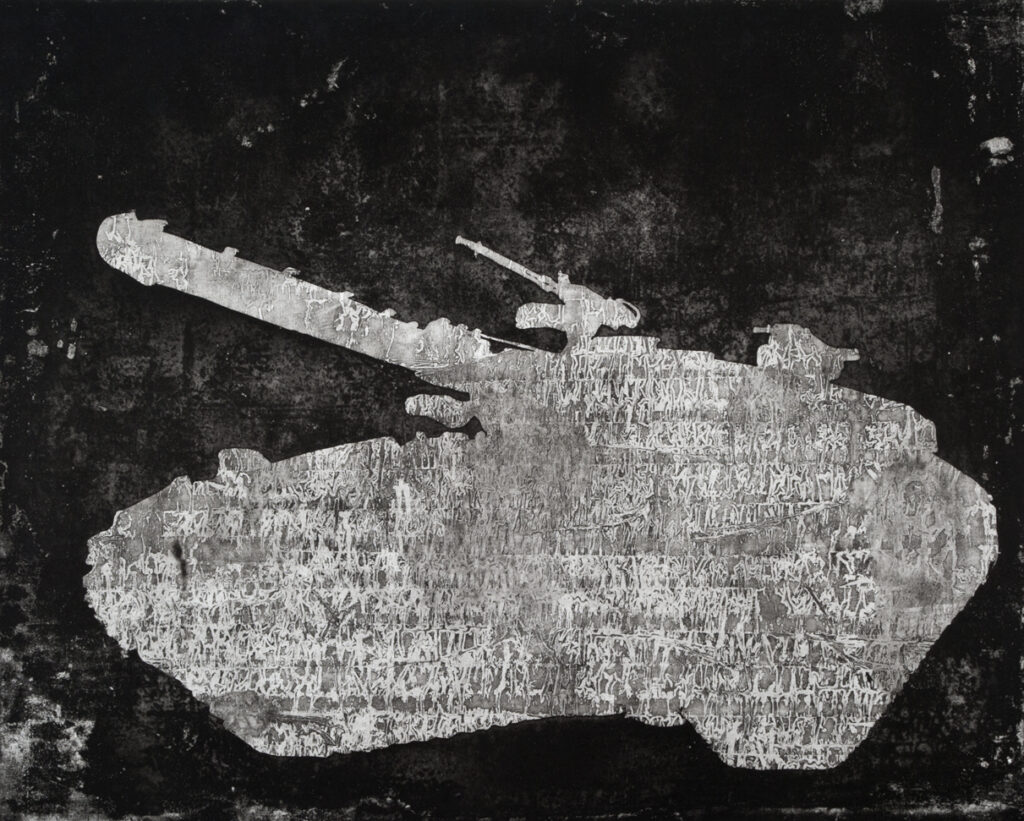
Landing III 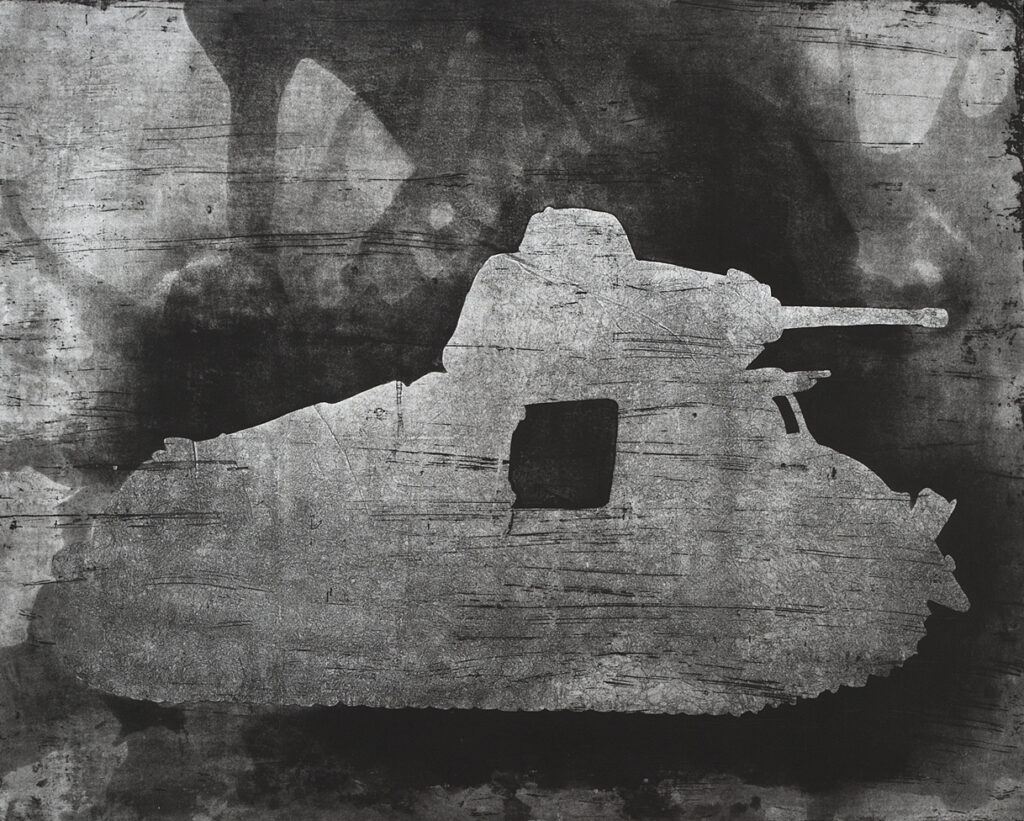
Landing V 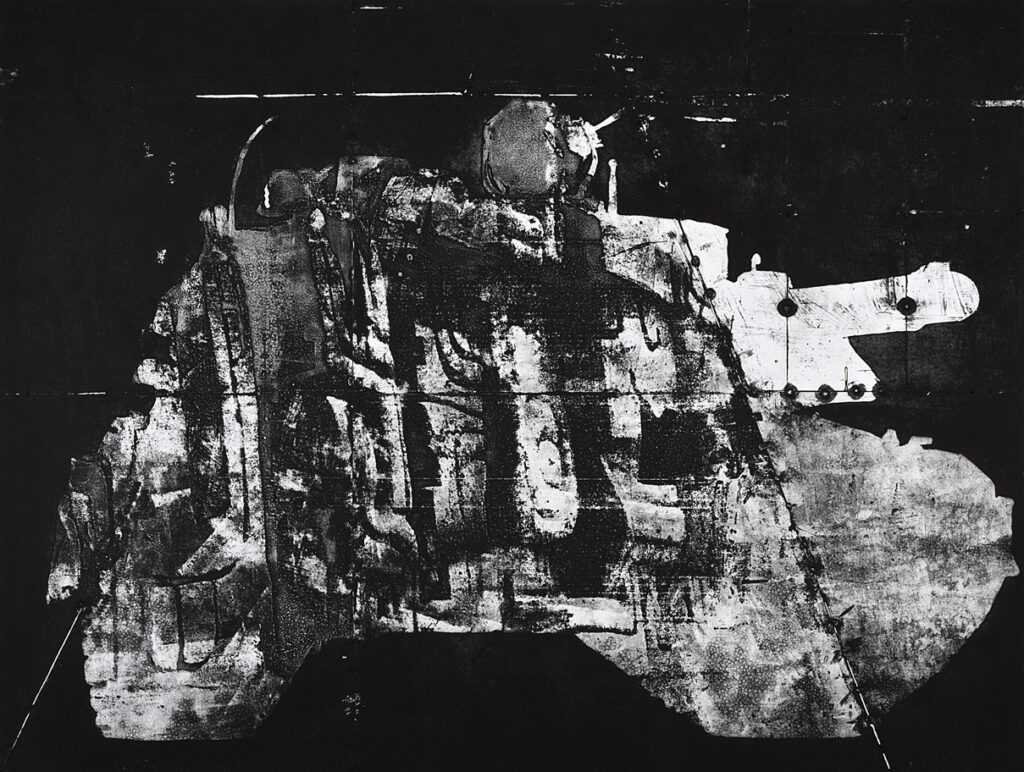
Landing XI 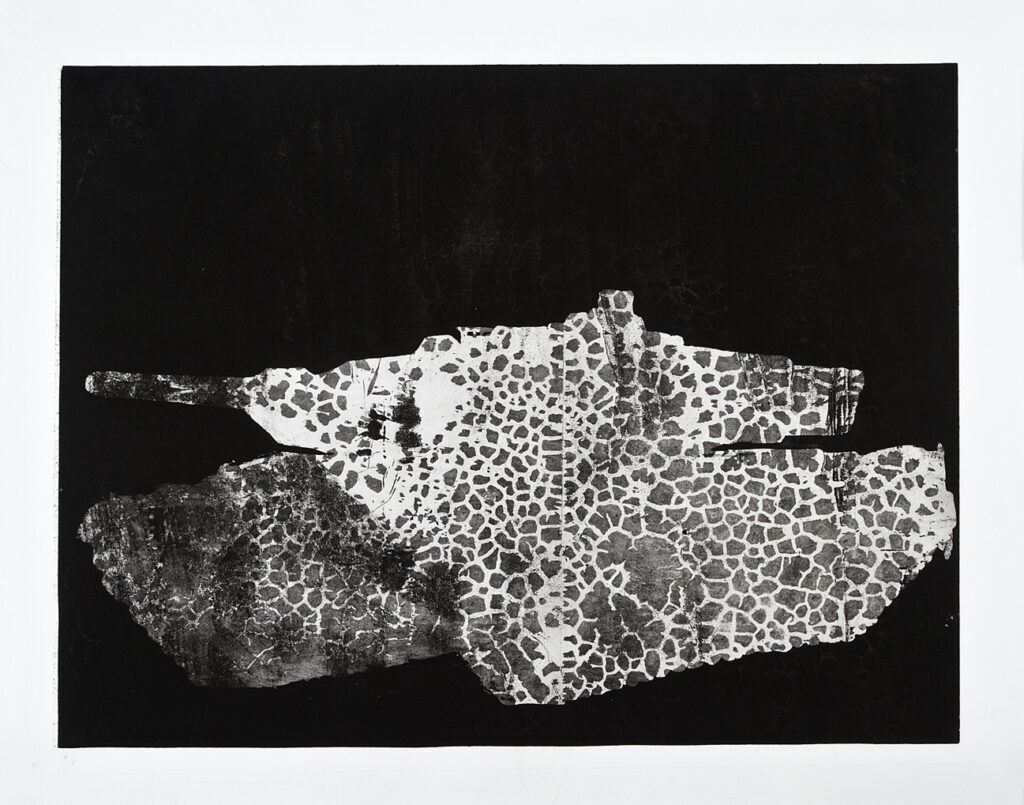
Landings I – Leopard 2 
Landings IX – ‘Sledgehammer’ 
Landing IV – Challenger 2
mimetics
Montalván Colón, Eugenia / Art in Belize = Export Quality? / ARCO Contemporary Art
Installation – Living and dead insects. Hand build environments which include wood, clay, glass vitrines, Supermarket bought flowers and dried and shaped leaves on oak branches.
Developments on the theory of Mimetic rivalry. Observations of violence recorded by duplication, in this case from the natural world, such as the mimicry by the hoverfly of the wasp. What other aspects of wasp behaviour does the fly adopt, apart from costume and flight pattern?

Mimetics I 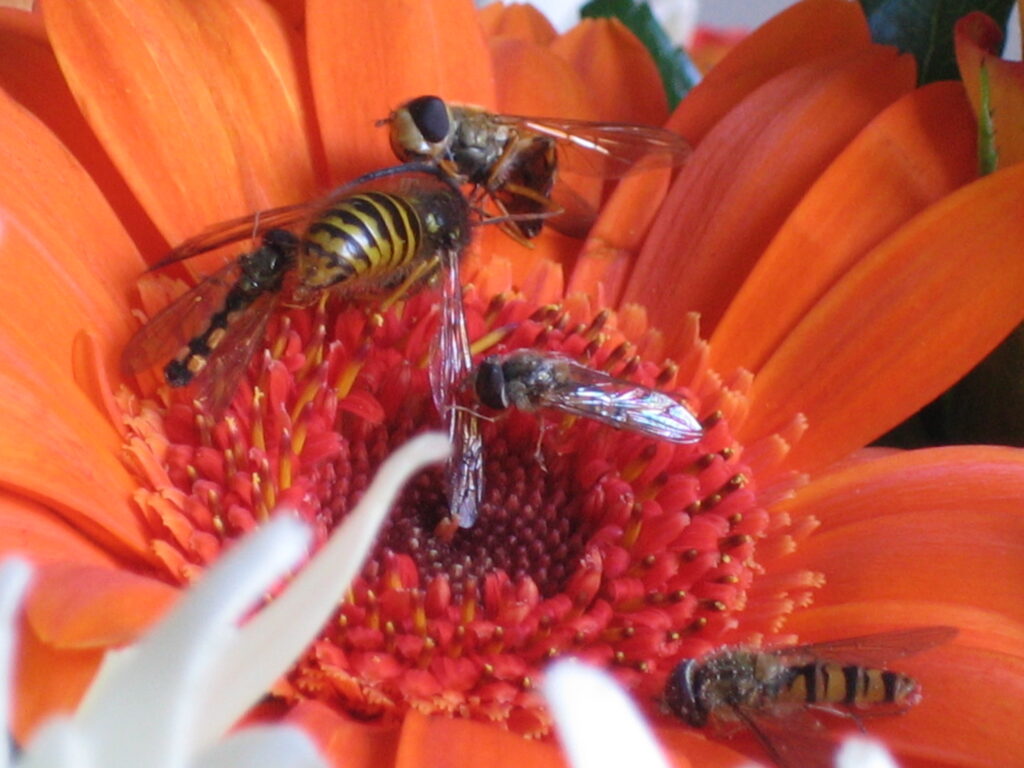
Mimetics I 
Mimetics II 
Mimetics II 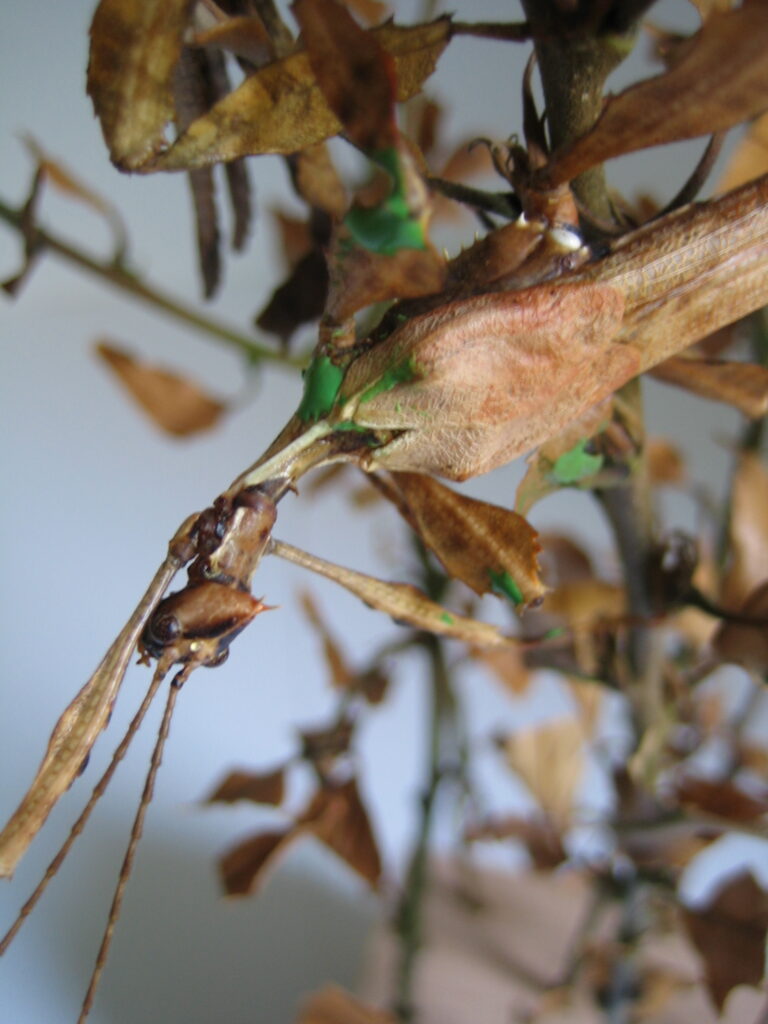
Mimetics II 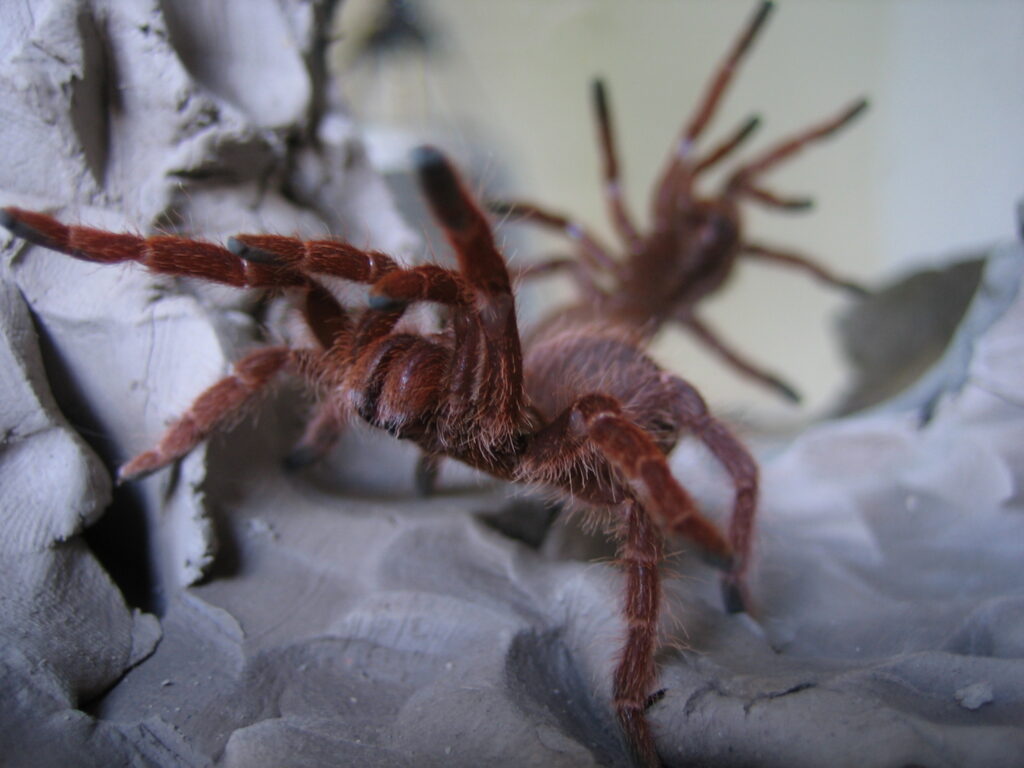
Mimetics III 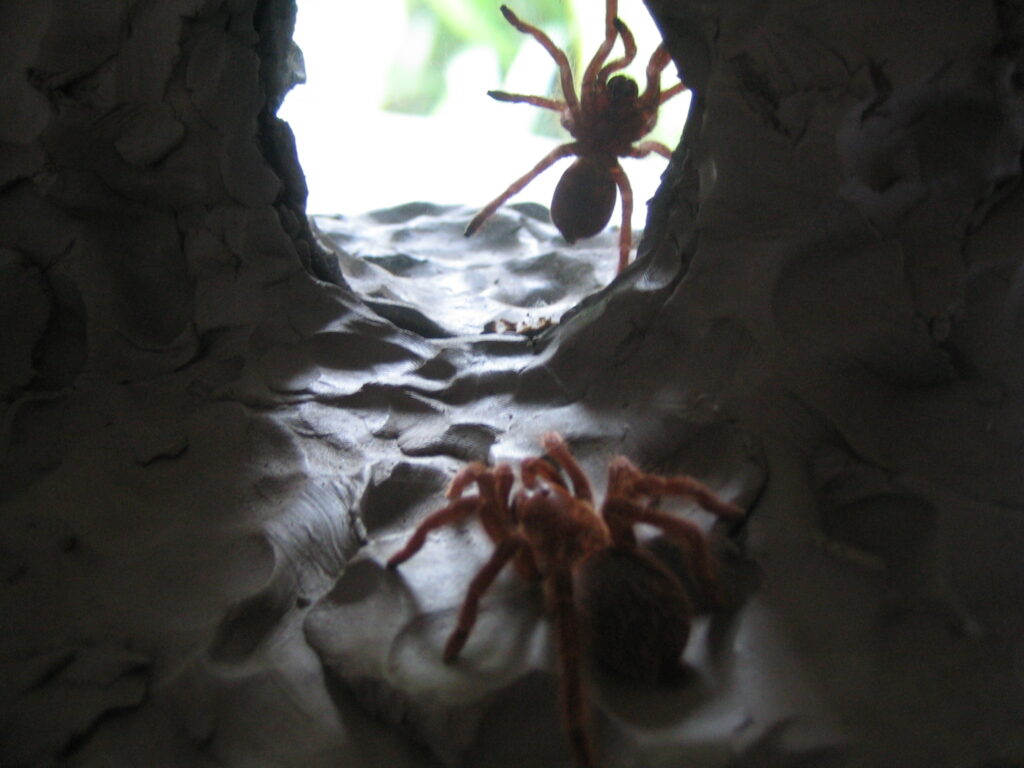
Mimetics III
Algonquians
‘Office Session 2’ Anchorage House, Docklands, London.
Series of Etchings on Zinc and Steel – Hard ground, soft ground, dry point, aquatint, spit bite.
Artist’s statement from exhibition:
Even in my short lifetime the words ‘war seems inevitable?’ are etched on my mind. How many kings, politicians and now media outlets have said this over time?
Historically, etchings have been used to record this ambivalent situation. The three series of etchings on display are from different projects, ideas and themes. In bringing these works together at Anchorage house’s ample unused office space, there is the possibility of reinterpreting the initial vision and creating a new narrative. The discerning viewer will notice that the groups on display are not armed, but in a state of flux – drawn together as an inseparable hive, by livery; individuality is denied in the swarm. The tanks are static, as if trapped in the wax used to create them, awaiting animation – and the houses are not on fire, but there is that possibility in the near future, if not controlled. This is life as we find it, precarious and oh-so unpredictable. Is this what is inevitable – the predictable unpredictable?
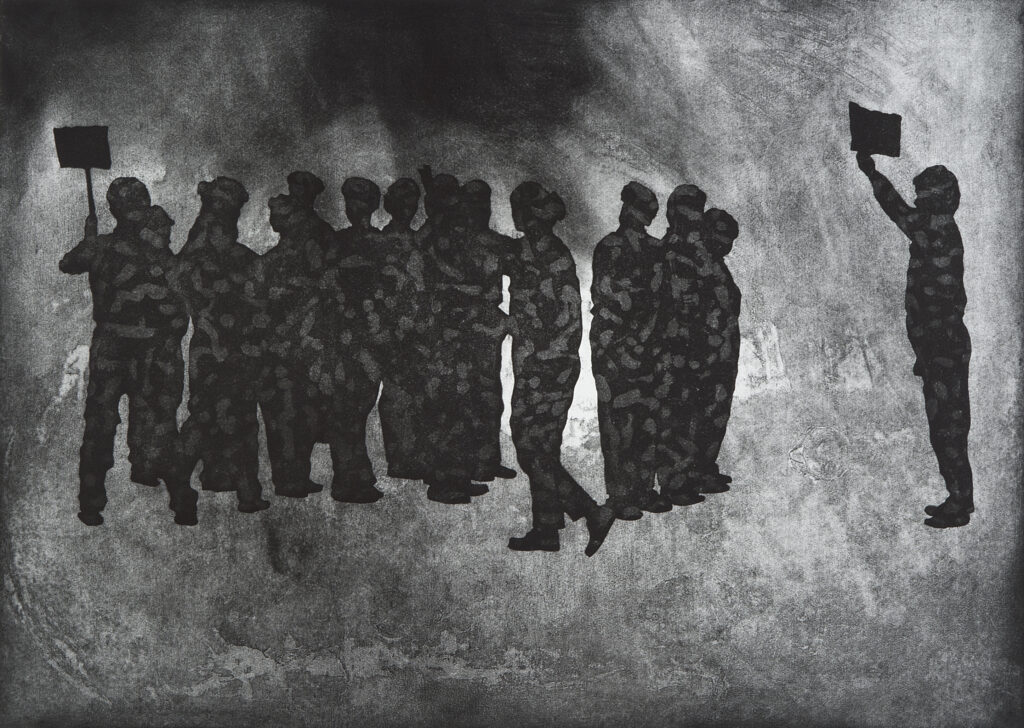
Algonquians – blind II 
Algonquians – smoke I 
Algonquians – blind IV 
Algonquians – smoke V 
Algonquians – blind VII
Camouflaging the everyday
Street Road Arts project space, Pennsylvania. USA
Studies – Hand painted soft ground etchings.
Proposed site specific work – Exterior painting of camouflage Nato livery to the buildings used by Street Road Arts Project Space.
The project space is found in rural Pennsylvania and is surrounded by major highways. The camouflage would not hide the builds but make them stand out; numbers invoke multiples. The audience going past on the road, would consider these buildings from
] new perspective: either from the perspective of abhorrence or even possibly excitement, all would take what they had seen in a few split seconds home for further discussion on its meaning.
